1lumen selects and reviews products personally. We may earn affiliate commissions through our links, which help support our testing.
Cyansky HS7R review
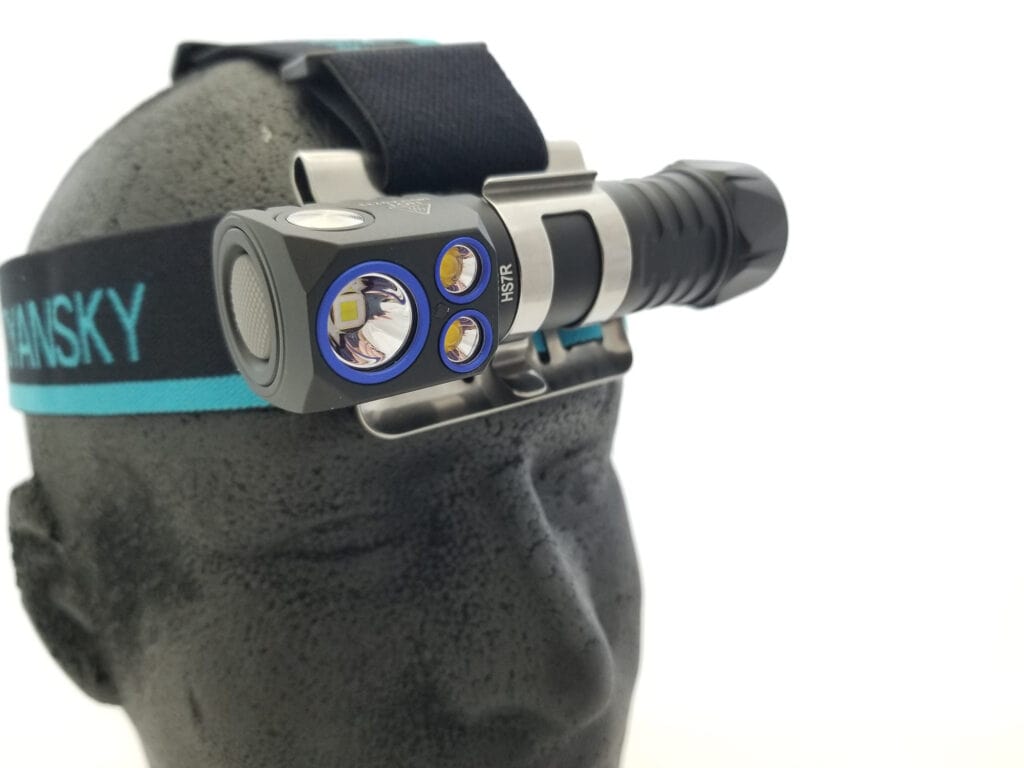
Cyansky HS7R specs
| Brand & Model | Cyansky HS7R |
|---|---|
| Flashlight category | Right Angle Headlamp |
| LED | 1*Luminus SFT70 2*Osram Duris P9 |
| Max. output | 2800 lumens max |
| Max. beam distance | 186 meters |
| Max. beam intensity | 8,649 cd |
| Battery config. | 1 * 21700 |
| Onboard charging | USB type C |
| Main modes | 4 |
| Blinkies | None |
| Waterproof | IP68 |
| Review publication date | June 2023 |
Review intro:
Before I coalesced into the portable illumination tool nexus, headlamps were just extensions of flashlights to me. To be honest, I wasn’t sold out to the idea of a flashlight dangling off the front of my face. After I bought a cheap D10 headlamp from the jungle site, any prejudice I had was quickly dispelled, and now I can’t think of a more useful illumination tool! Whether T-type or right angle, headlamps are more than a head-mounted illumination tool. Often sporting multiple LEDs in various tints, low or high CRI, floody or spotty, behind reflectors or TIRs, and even mules, headlamps have become extremely versatile.
I’ve reviewed quite a few, and one of the better ones was made by Cyansky (pronounced sy-an-sky). And it basically means: sky with a cyan color. They’re a relative newcomer to the flashlight scene, launched in major markets in 2021 thanks to e-commerce partner Freasygears.com. Fast-forward a couple years, and they’ve got their own merchant site, and things are booming!
The first Cyansky HS-series headlamp I reviewed was the HS6R, a T-type 18650 size headlamp with a spot/flood plus red LED TIR setup in one unit. I took it camping and it sure helped during a middle-of-the-night venture to the pit toilet, which required traversing a steep slope. Believe me, with a roll of butt wipe in one hand, and wet wipes in the other, having both those hands free was incredibly helpful, and a guy would have paid about $1000 for that privilege.
I reviewed the HS3R, which was a right angle 16340 size headlamp and found it to be really useful also. Well, now there’s a new one, the HS7R. It’s another right angle design, with combination spot/flood LEDs, but this one has a 21700 battery and a redesigned headband mount. I think Cyansky had a familiar Fenix headlamp in its crosshairs (guess which one) when they designed the HS7R, since there’s some similarities between them. The Fenix is a fantastic headlamp and pretty much the benchmark in this segment, so let’s see how Cyansky’s all-new 21700 right angle headlamp stacks up.
Package quality.
The HS7R came in quite a nice box! It eschews the typical cheap-looking cardstock boxes I’m used to from Cyansky, and bumps the elegance factor up with a sturdy box with a magnetic flap lid that’s more typical of something I see from Olight. The graphics are the typical Cyansky blue and white color scheme with pictures of the light and some specs. I like this trend! Flipping open the lid reveals a piece of microcell foam with a cutout that the front of the HS7R sticking through. Here’s what’s inside:
- Cyansky HS7R headlamp
- Cyansky BL2150U 5000 mAh 21700 battery
- Manual
- Warranty card
- USB type C charging cable
- Mesh carry bag
- Spare o-rings
- Headband with mount
As usual, this is the standard loadout for this type of headlamp. Including the battery is a nice touch and keeps it competitive with offerings from Fenix, Nitecore, Acebeam, and Olight. This is a ready-to-run package. No charger required, no battery required, which most people who buy this light will expect. The included battery has built-in USB type C charging, and it’s a high quality cell. The carry bag is a nice addition as well.
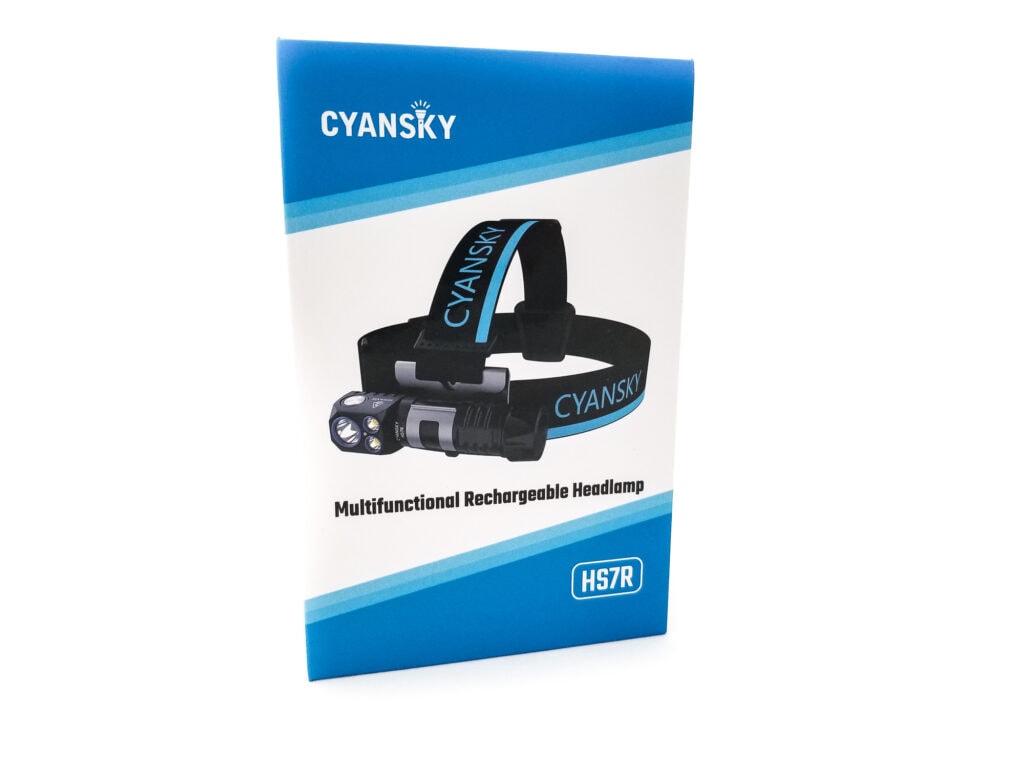
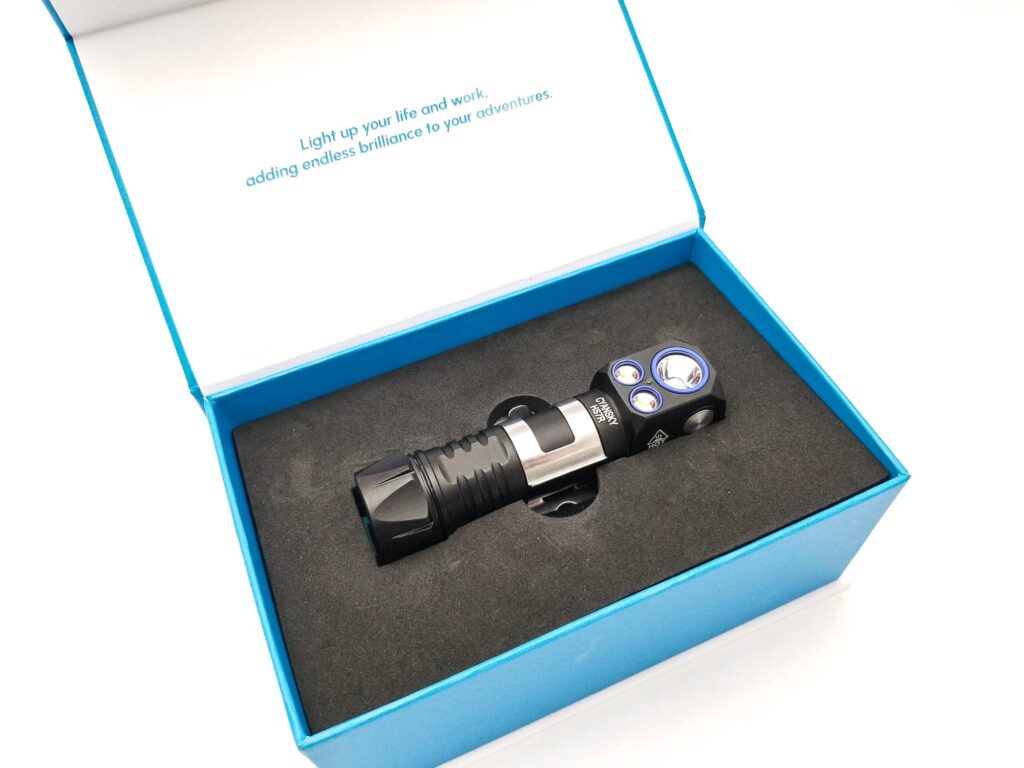

Flashlight in use
This is an L-shaped flashlight. I call it a flashlight because it’s more a flashlight than a headlamp (even though it can be both). The HS7R is a very compact unit for a 21700-size form factor. It’s also surprisingly lightweight and handles very well in handheld mode. In the headband, that light weight is very useful in reducing neck fatigue, and really makes the HS7R feel like a smaller headlamp, a bit like the Biolite 800 Pro. For a 90 degree headlamp, which doesn’t benefit from having a centrally-mounted light source like a T-type headlamp (which I actually prefer), it does well with comfort and light distribution.
The sturdy stainless steel headband mount is re-designed from the HS3R and HS6R to allow the light to be more easily removed and installed in the mount. Cyansky also added some lube from the factory, so it’s smoother and rotates more easily in the mount. The headband has a top strap that goes over the top of the head for added stability during vigorous activities, and this design particularly shines when used with helmets. The headband is very comfortable, even more so than the Fenix ones I’ve used, and the wide strap has plenty of stretch and it’s very soft, nearly velvety. It can be removed from the mount for cleaning as well.
Holding the HS7R in the hand is equally nice.
The balance is neutral, and it points easily and naturally. It’s light and compact enough to be easily pocketed, something I couldn’t say for the Fenix HM71R I reviewed, which was a bit heavier. Up front, the HS7R features a proximity sensor that automatically reduces the output on High and Turbo modes if an object is placed within about 10 centimeters. It’s pretty unobtrusive, and worked fine (it can also be disabled easily).
The tailcap has a pretty stout magnet, and it really clings to magnetic surfaces, and easily holds the HS7R at a 90 degree angle. There’s two switches at work here, one on the top, and one on the side. The top switch has a large grippy silicone rubber button that’s backlit for battery, charge, and on-state. The side-mounted button is a smaller round metal button with circular patterning to help with grip. It barely sticks out, so finding it by feel was a chore, but the top button was easy peasy.
The side switch wasn’t the best for feel or function, with a modicum of travel, and a vague, mushy action and nearly nonexistent clicks. The top button was the best, with nice clicks and good feedback. There’s a USB type C charge port on the back of the head, which has shallow heat sinking fins. The cover is rubber, and it takes some effort to fully seat, so make sure to firmly press it down.
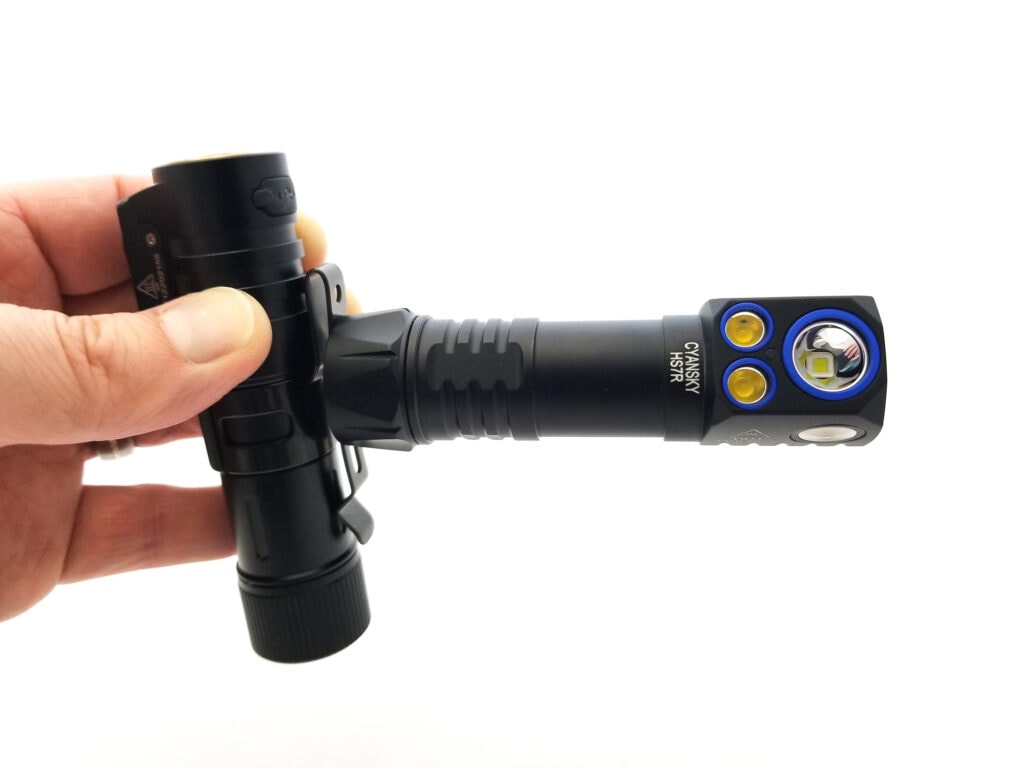
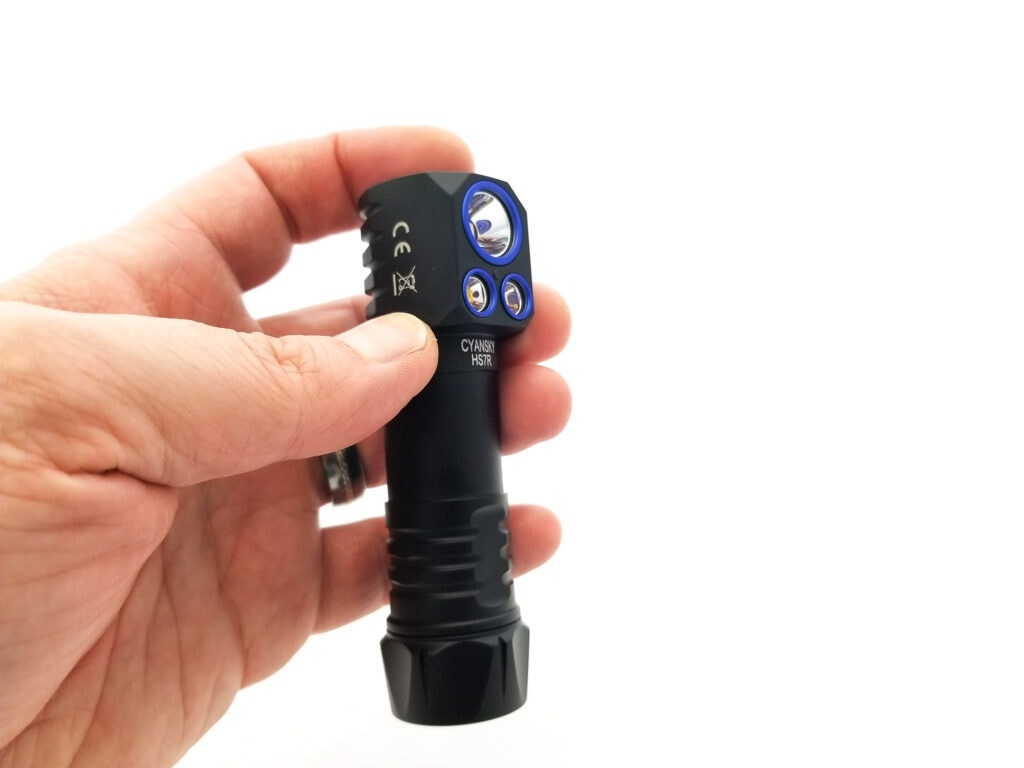
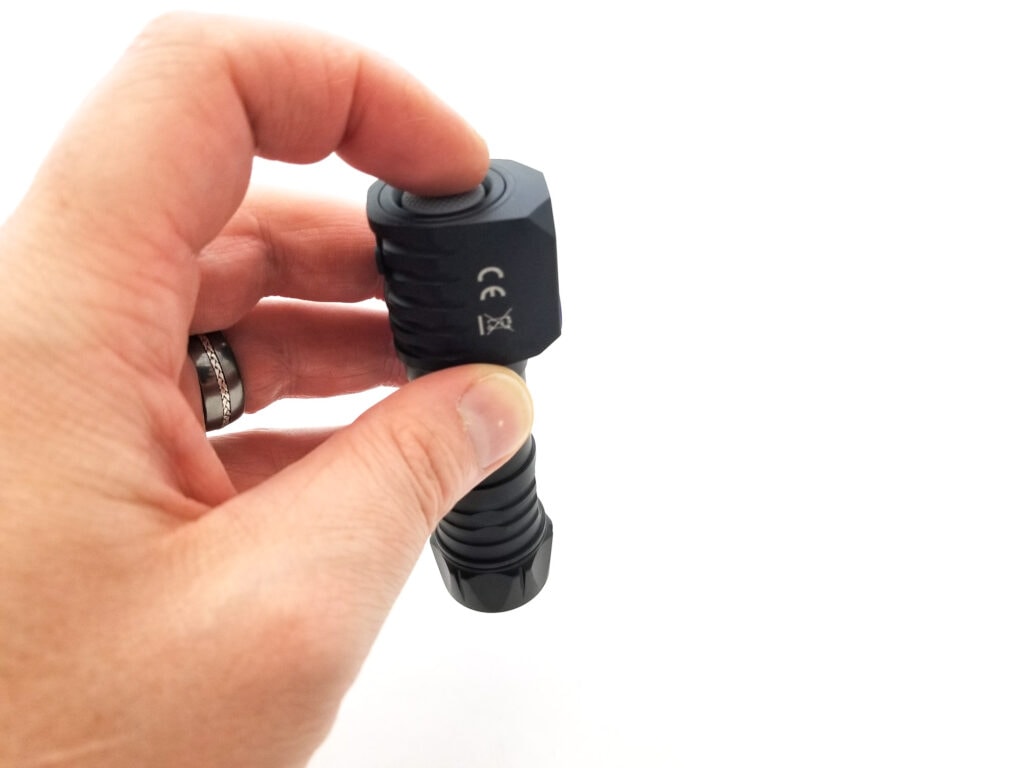
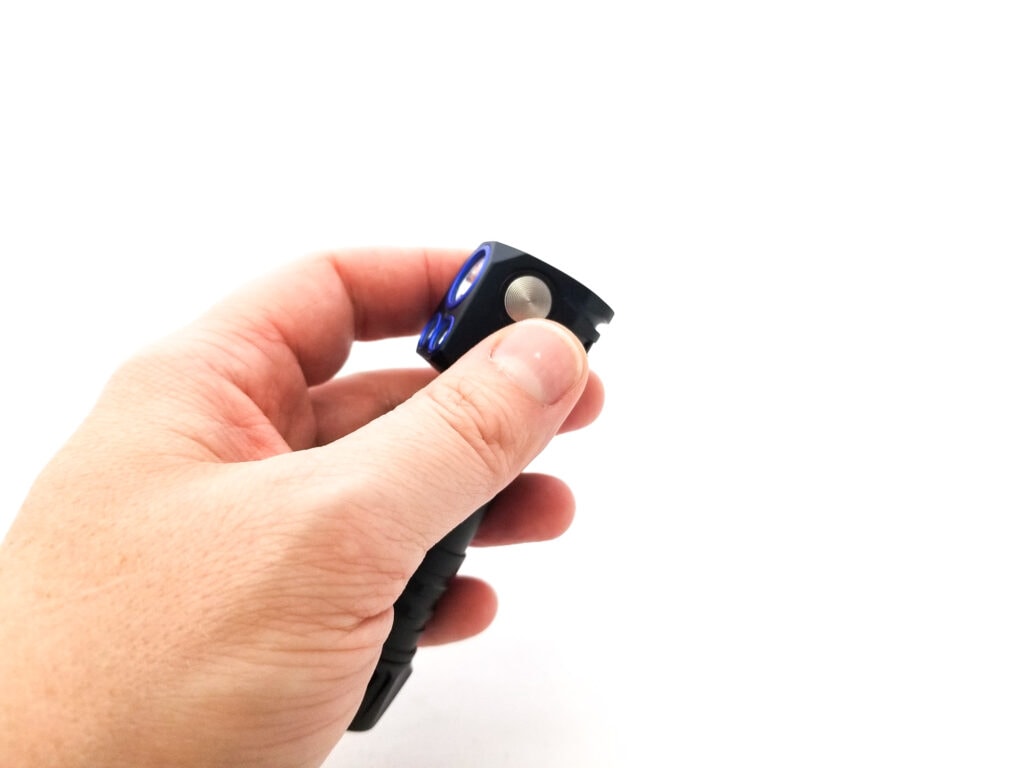
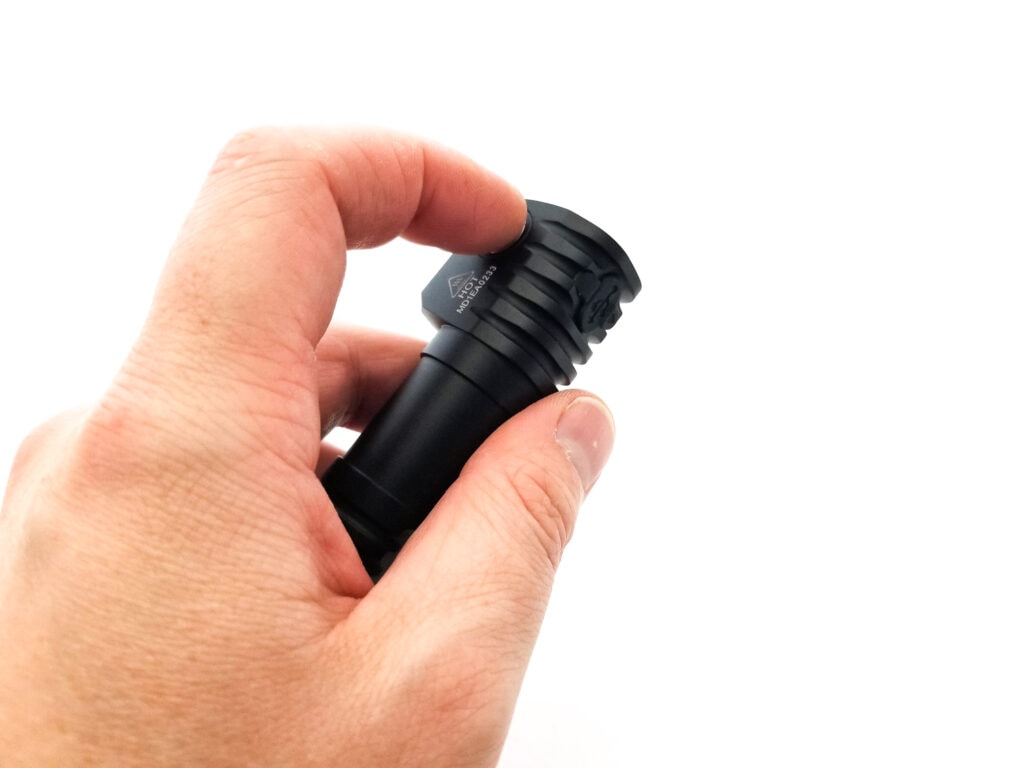
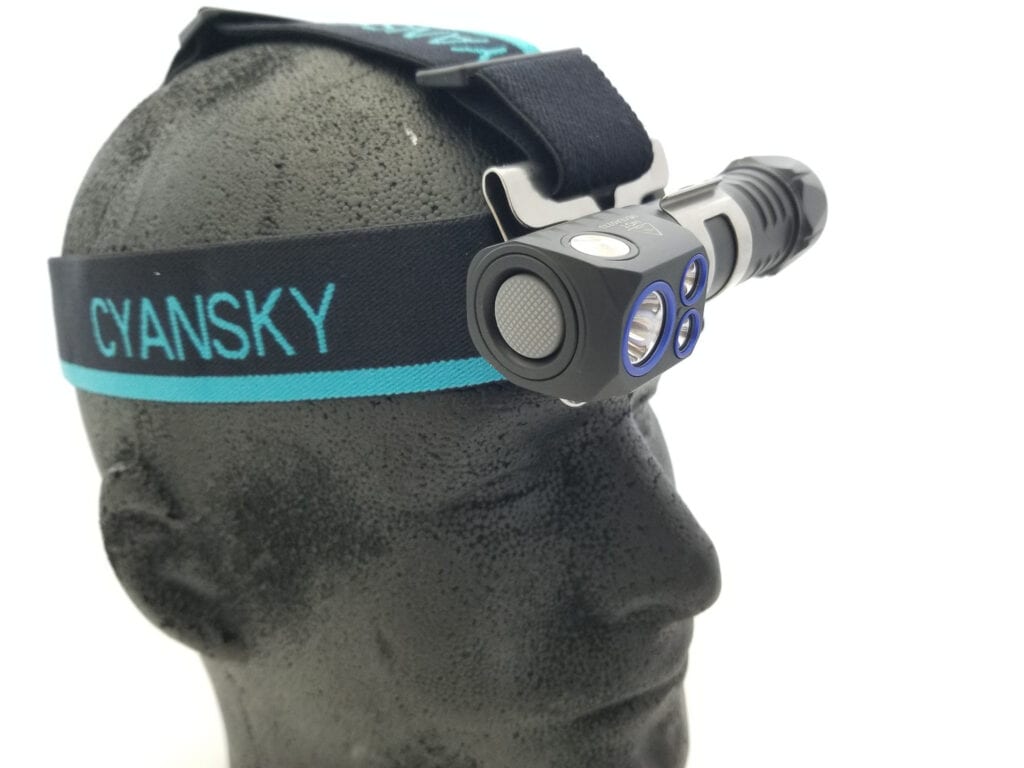
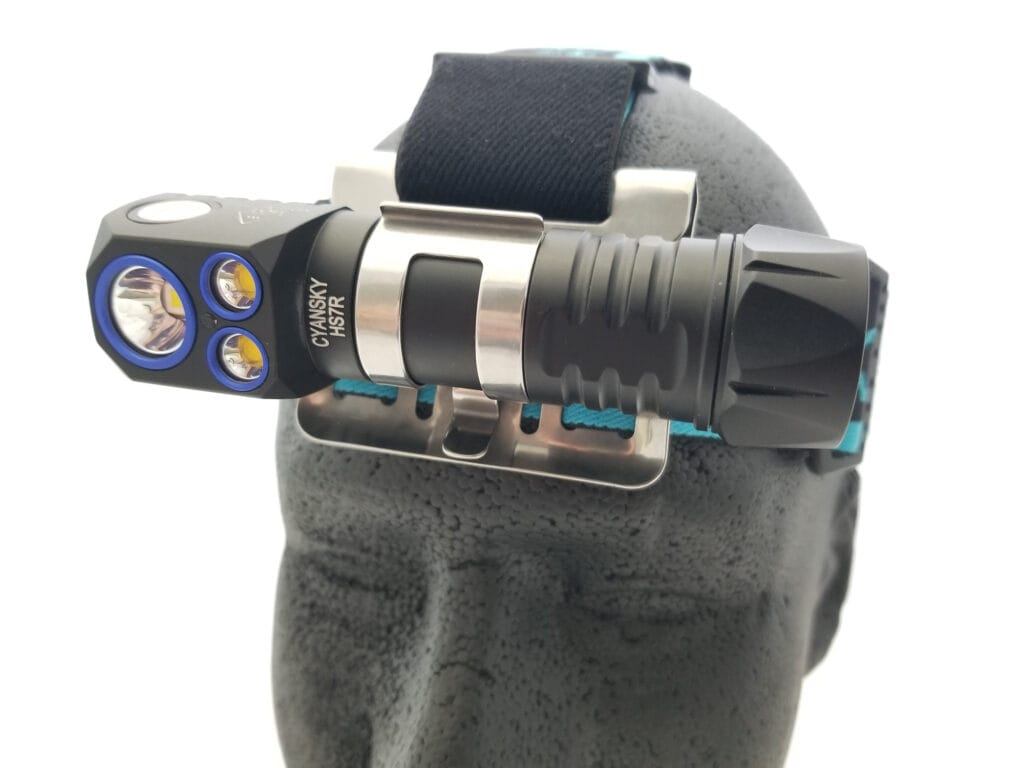
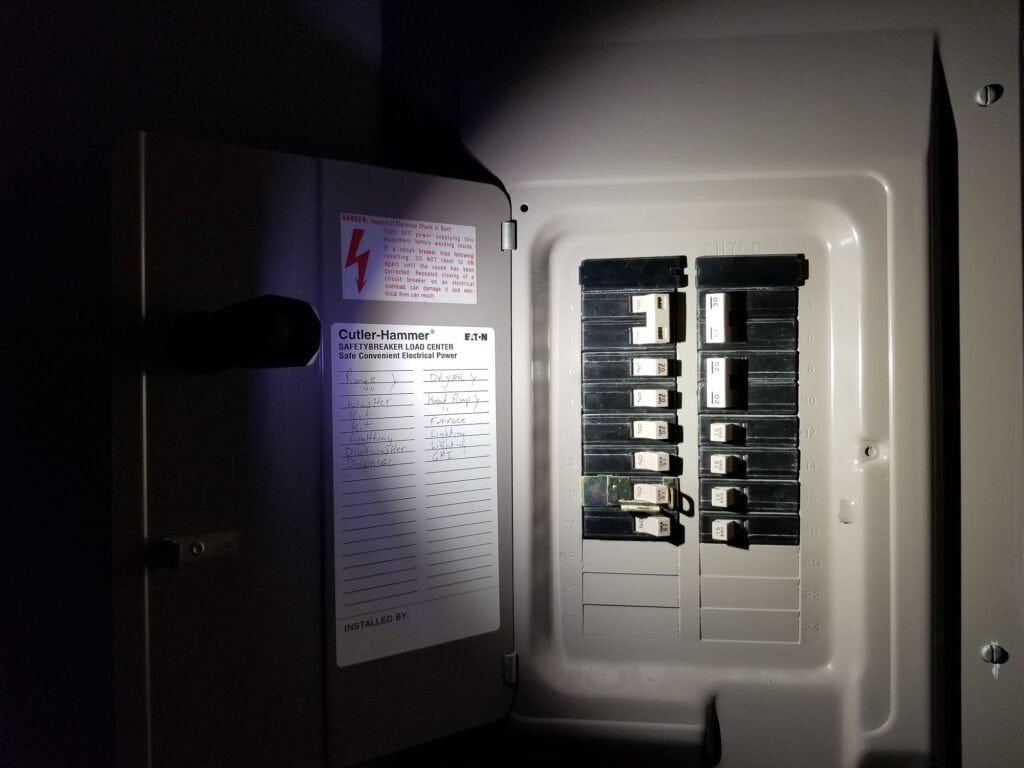
Build Quality and Warranty
This isn’t the first Cyansky product I’ve reviewed, and the consensus for each has been the same. These are well-made, high quality flashlights with great build quality that’s easily a step up from Sofirn, Wurkkos, Mateminco and other brands I’ve reviewed. Cyansky prices the HS7R at around $110, and that seems like a lot, but discounts bring it down even more, and even still, it’s competitively priced against offerings from Olight, Fenix, and Nitecore.
The build quality is fantastic, as expected at this price point. All the parts fit just fine, no gaps, no oddball angles. The machining and finishing is perfect, and all the edges are knocked down and smoothed. There’s no anomalies with the anodizing either, even down to the beautiful blue bezels trimming the reflectors. It’s a semi-matte, and very nicely done bog standard type III HA that manufacturers like to throw around, but I feel like Cyansky’s finishes are some of the better ones, and so far it’s held up fine after I took it camping.
Moreover, the body is still pristine even after being mounted and unmounted from the headband multiple times. My other Cyansky lights are also holding up great, and believe me…they get used. The light cannot be disassembled. The head and tube are either one piece or very finely fit-up and glued together. Only the tailcap can be removed, revealing thick, rectangular cut fully anodized threads with a single o-ring.
These threads were lightly lubed and pretty smooth. The tailcap spring is pressed in and is substantial with a gold plating, and yes, it’s magnetic since the battery clings to it. The charge port cover fits precisely to the cutout in the head, and helps the HS7R earn an IP68 water resistance rating, so yes, I’d feel comfortable if I got caught in the rain while enjoying a pina colada.
Warranty? From Cyansky: 15 days free replacement: Cyansky Light will offer a new replacement within 15 days of purchase for any manufacturing defects if the problem occurs in normal use. In case the model has been discontinued, the customer will receive a similar or improved model in time.
60 Months free repairs: Cyansky Light will offer free repair within 60 months (5 years) for lights from the date of purchase if problem happens with normal use.
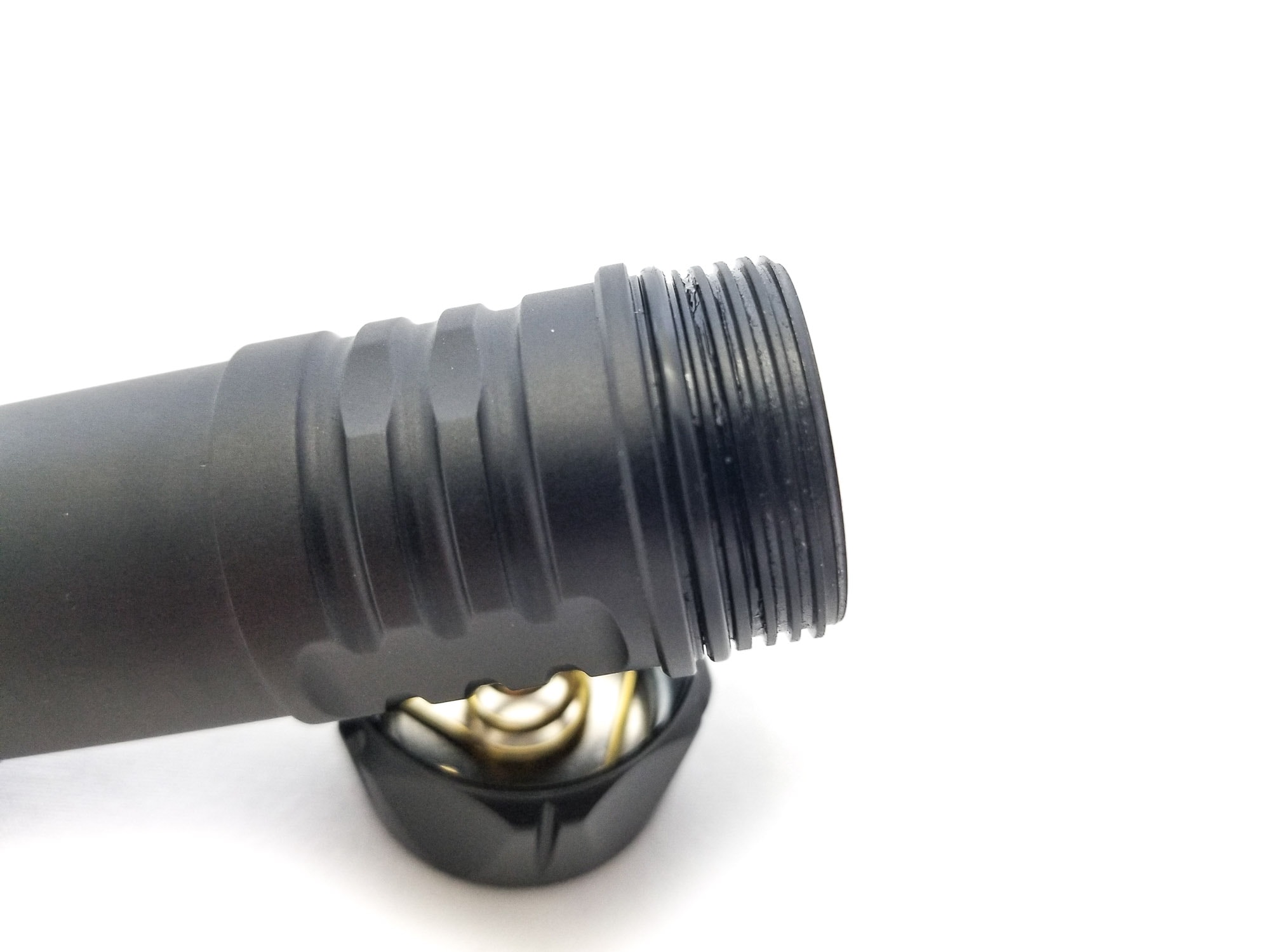
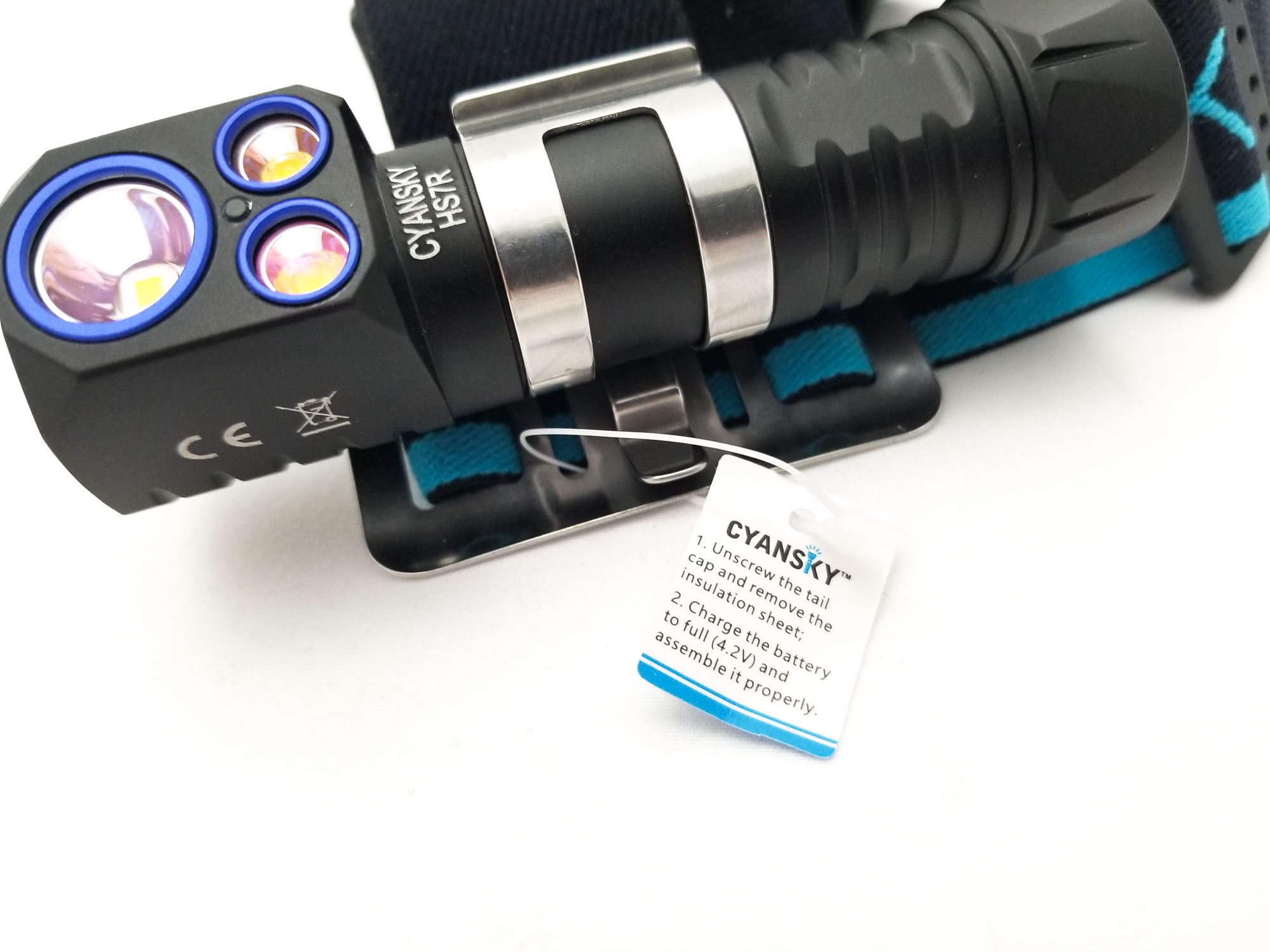
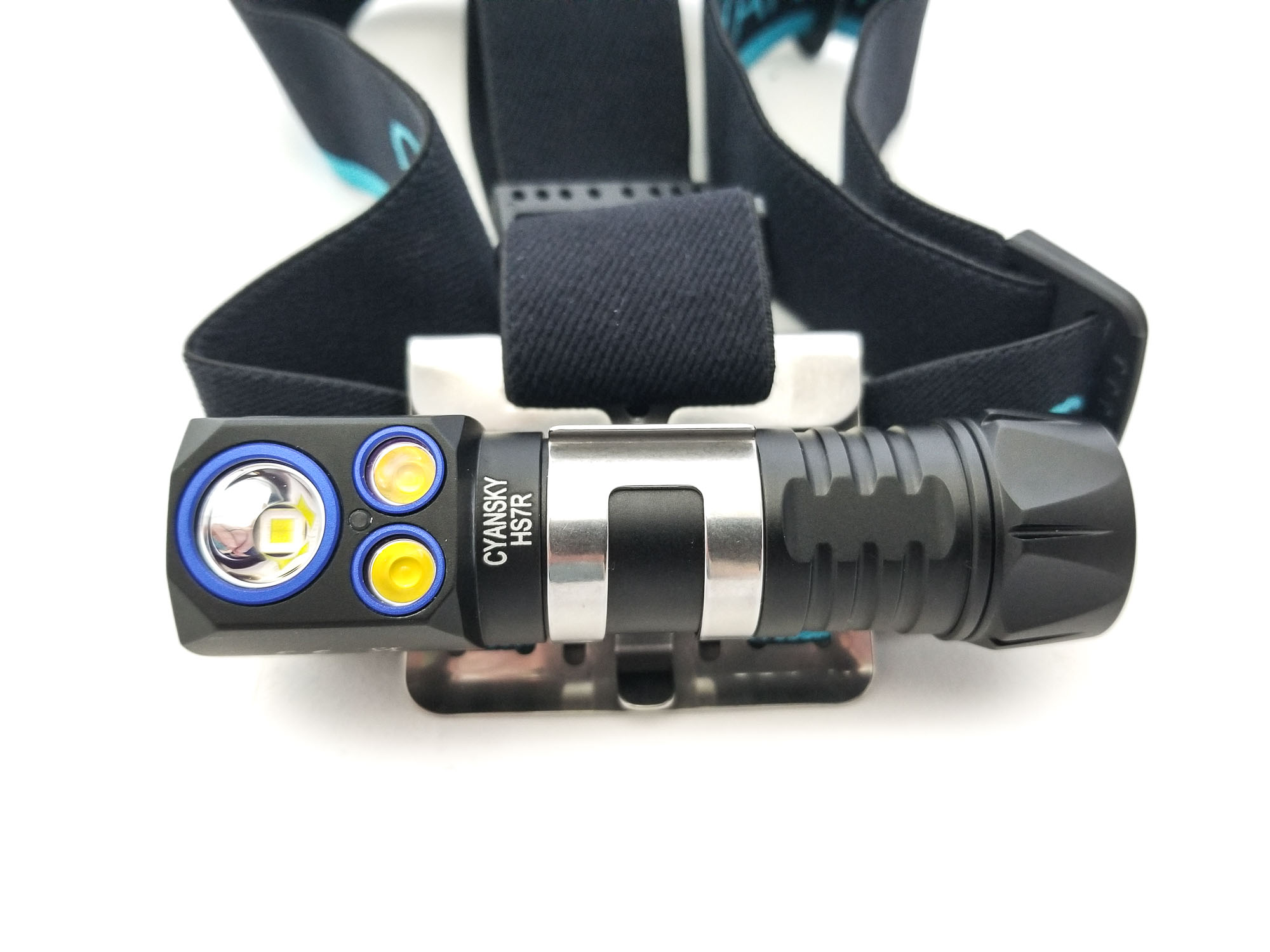
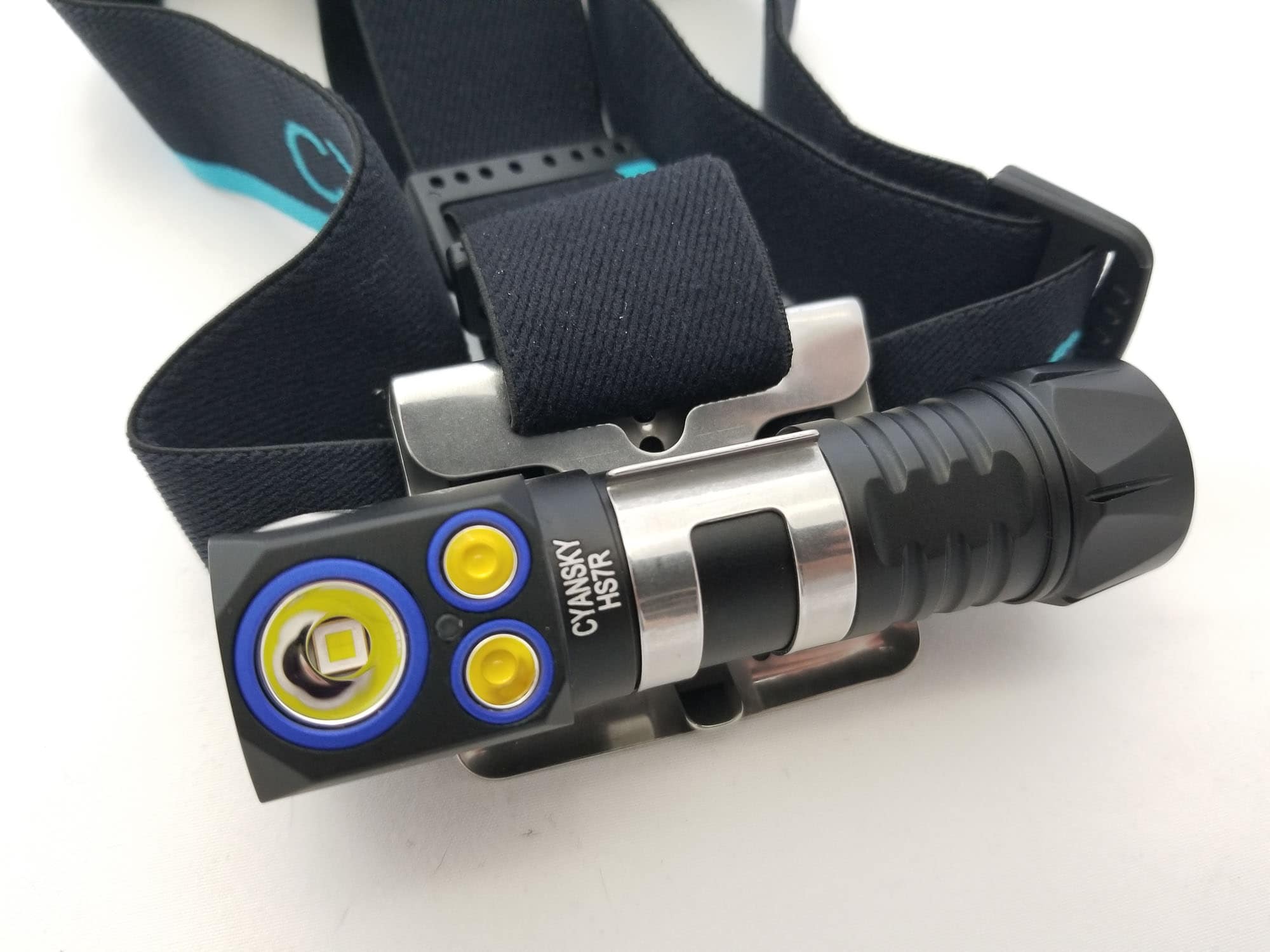


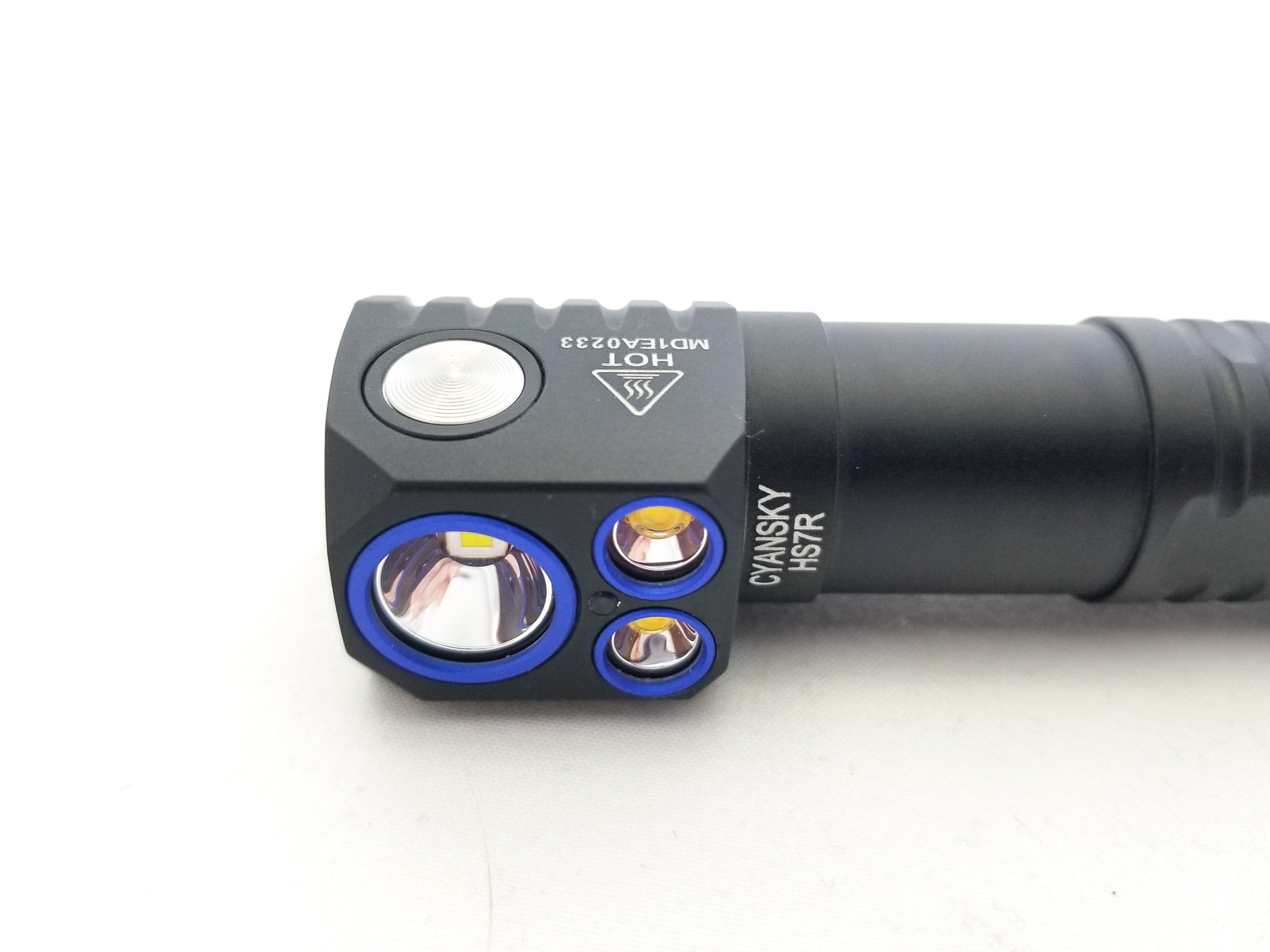
LED, Lens, Bezel, Beam, and Reflector
Since this is a multipurpose, really a dual-role headlamp/flashlight, the LEDs and reflectors reflect this. Just about every headlamp worth its salt these days is sporting two or three LEDs of differing tint and/or beam characteristics, output, candela, etc. For instance, the Fenix HM71R has a high output spot light, and a floody lower output, warm white high CRI LED. Some incorporate red lights. The original HS6R has a triple LED setup with a cool white, high output spot light for distance, a high CRI, warm white flood LED, and two red LEDs behind their own TIR lenses.
The HS7R deletes the red LEDs and the TIRs, and retains the high output spot LED and warm white flood LEDs. The spot LED is the Luminus SFT70. This is a domeless, high output quad die LED. This one’s a newer design and can be driven pretty hard. It’s 6 or 12 volt only, so you need a boost driver or series cells to run it. The domeless construction increases candela a bit over the domed SST70 without an output deficit. While not as efficient as the Cree product, it’s a good high power LED. It’s listed as CW, 6500K.
The flood LEDs are familiar faces in the flashlight world, the OSRAM Duris P9. This is a bit of an oddball 3737 size 3 volt LED similar to the Cree XP-L2, albeit with lower output and higher thermal resistance. These are the warm white versions, and while the tint is pleasant (if not a bit orange to the naked eye), they’re not high CRI. The Opple Lightmaster Pro has the flood LEDs coming in at 4121K and CRI Ra 64.7. The duv is 0.0074 and skewed towards the orange end of the BBL.
The Cree XP-L HI V2 5D I tested in the Fireflies E07 2021 has a much nicer tint and higher CRI at around 85. The spot LED is indeed cool white, coming in at 6726K and CRI Ra 71.1. The duv is 0.0051. The beams fit the use-case perfectly. The spot LED does exactly that, projects a well-defined large even area of light with diffuse spill and good beam distance The flood LEDs do a great job at…flooding!
There’s no hotspot, just a wide swath of evenly distributed light that also has decent distance. The flood LED ttint is good for cutting through fog, smoke, or dust, something that came in handy during my beach trip.
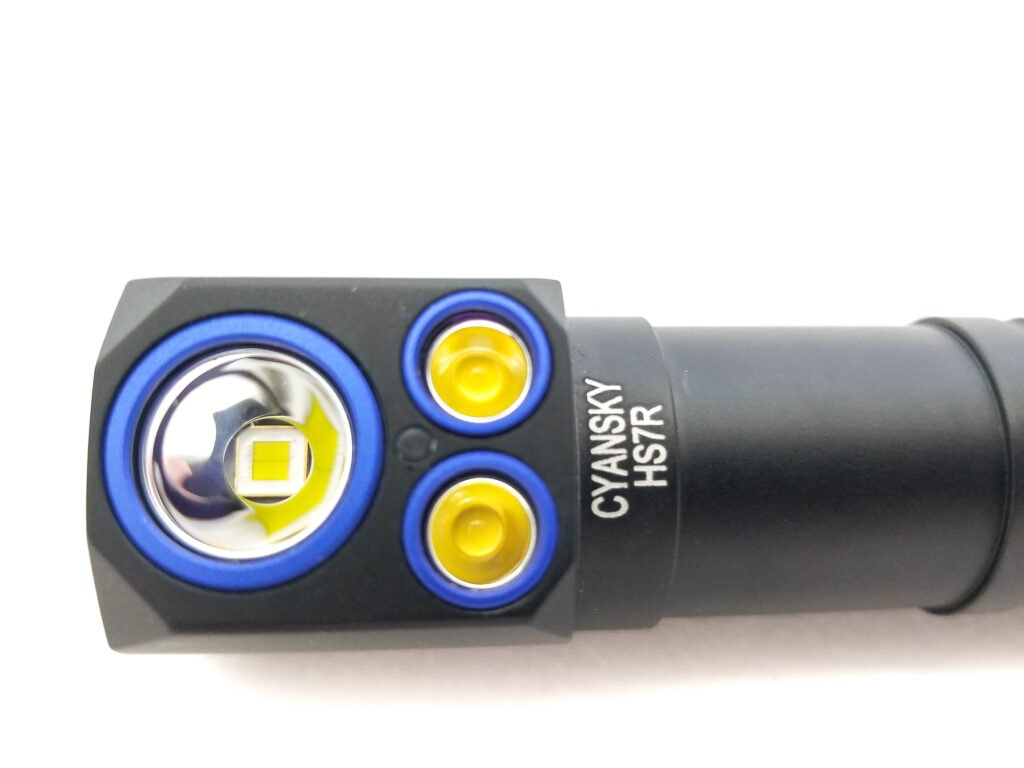
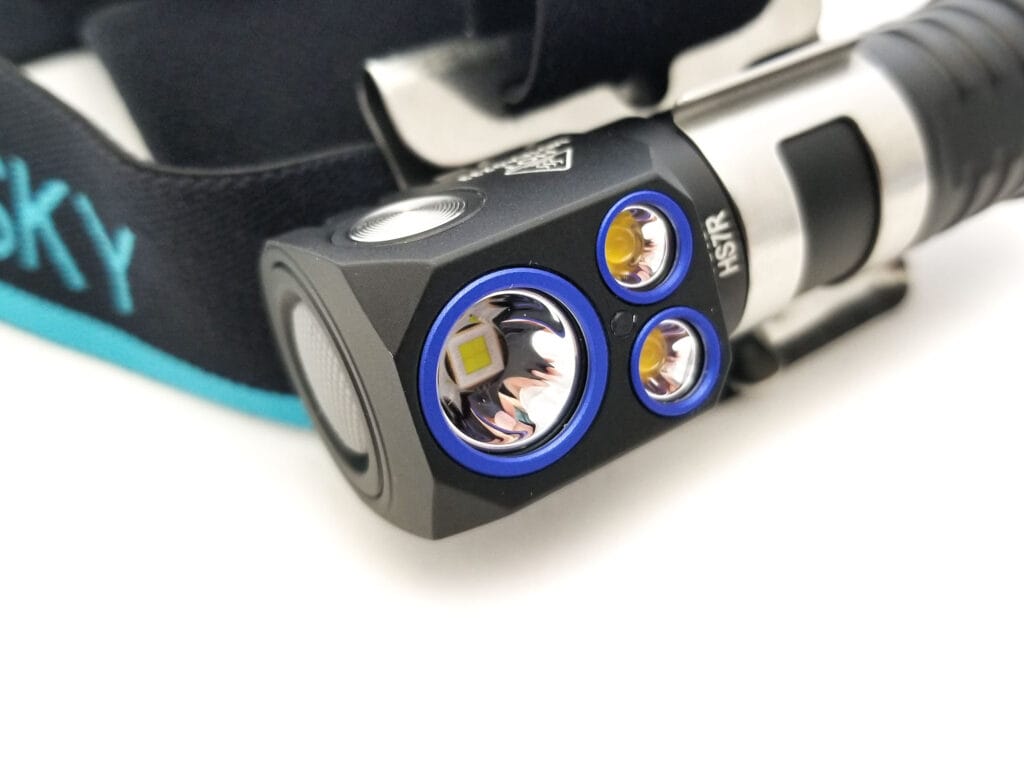
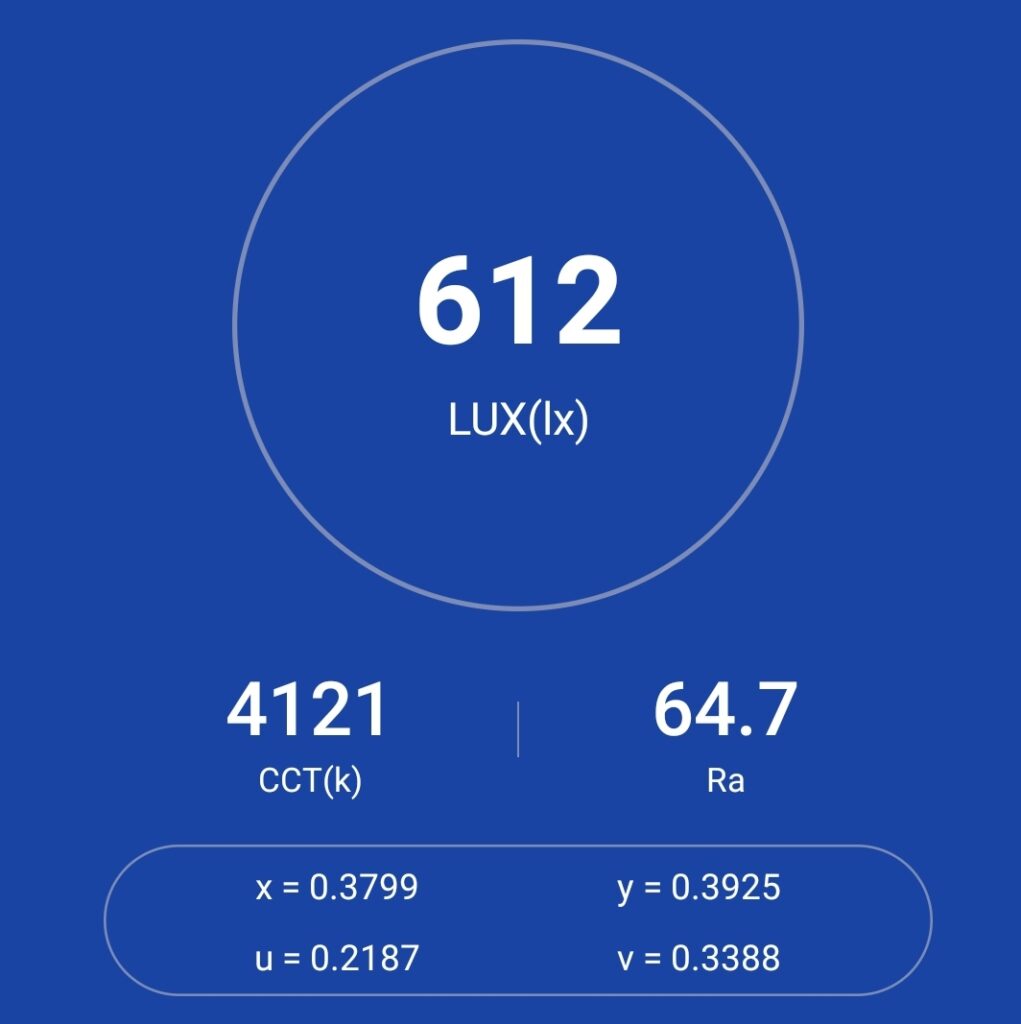
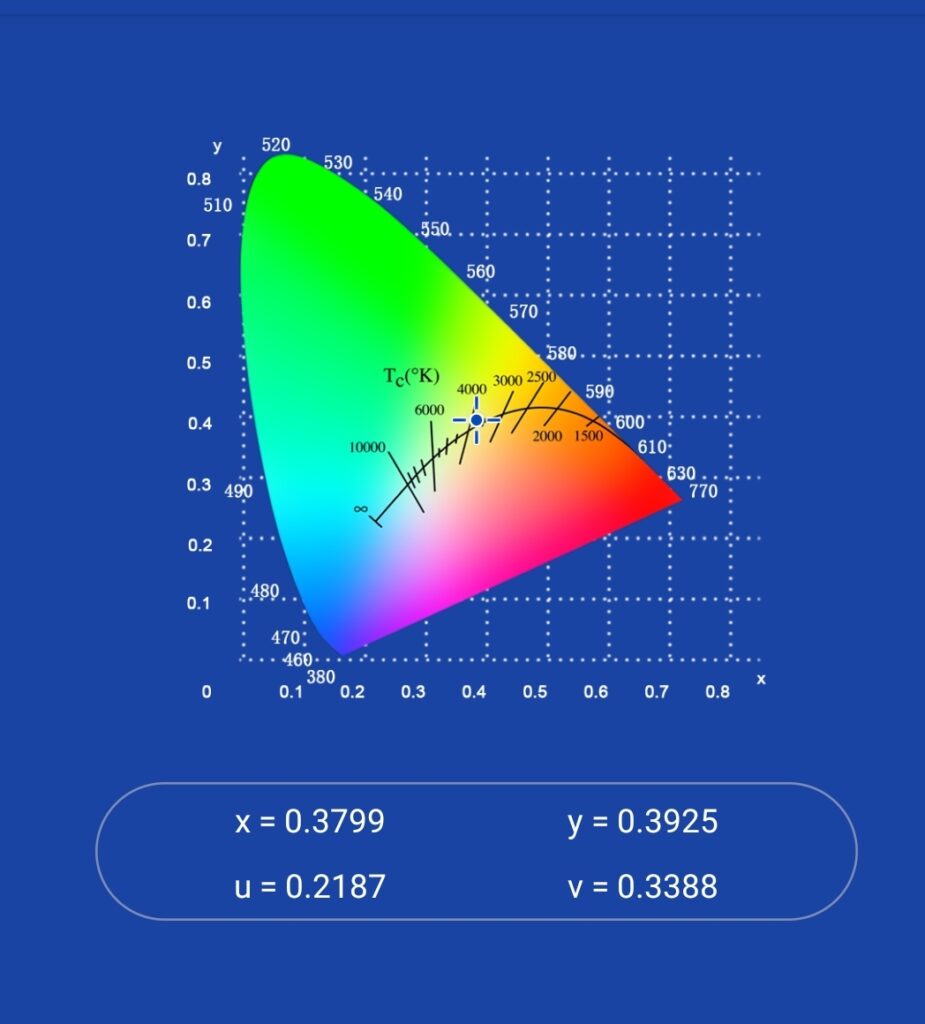
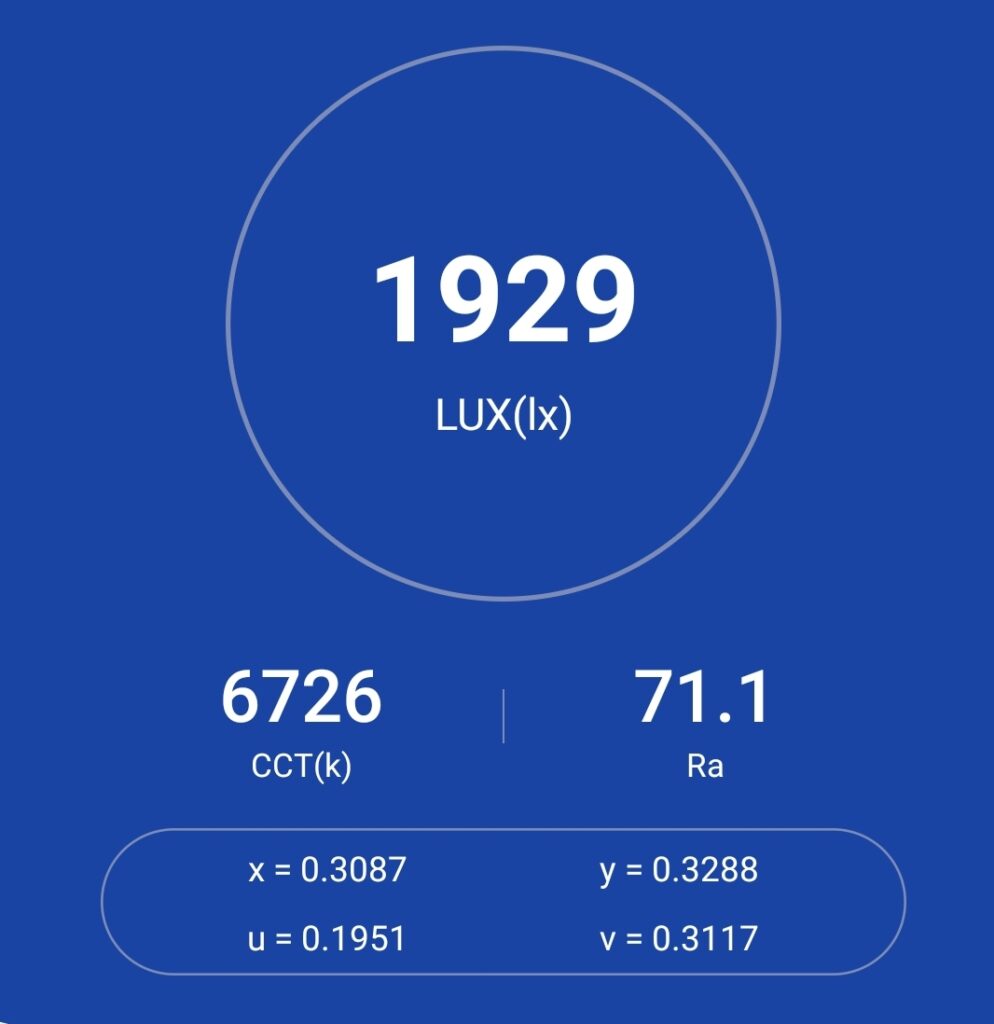
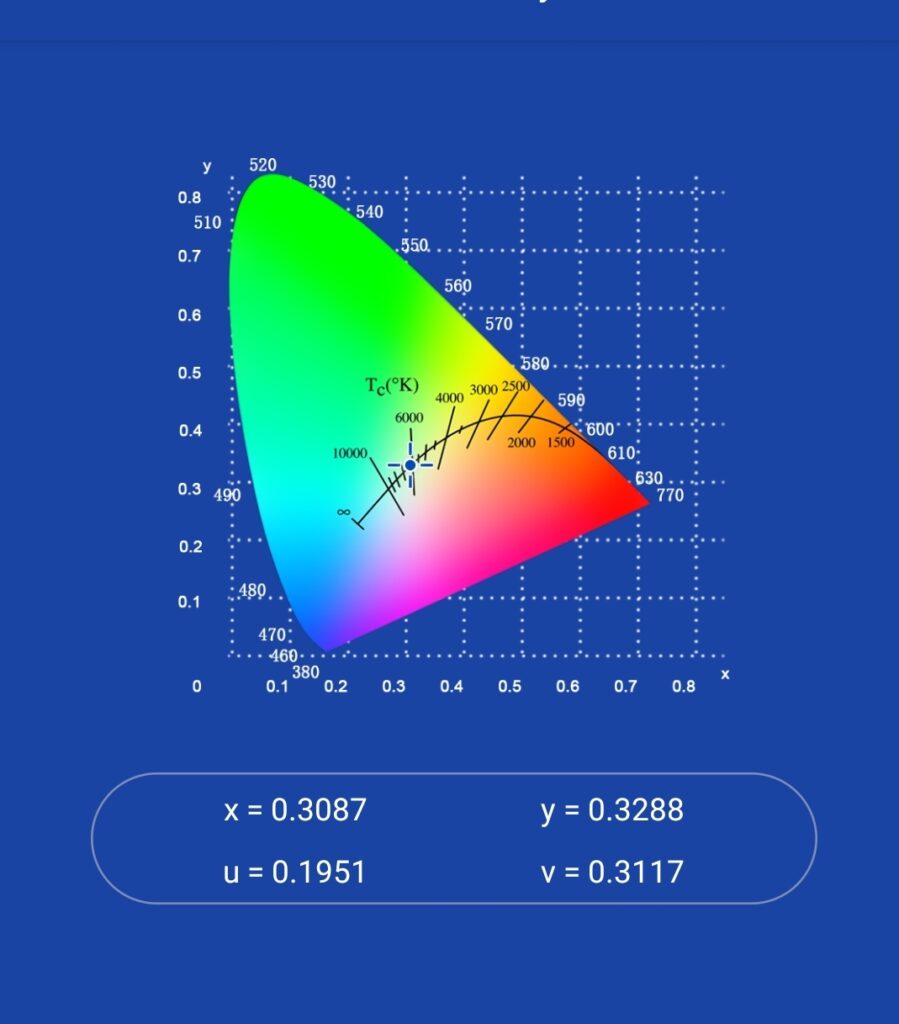
Dimensions and its competition
| Cyansky HS7R | Millimeters | Inches |
|---|---|---|
| Length | 103 mm | 4 in |
| Head diameter | 32 mm | 1.3 in |
| Body diameter | 26 mm | 1 in |
Dimensions are rounded to the nearest millimeter, and to the nearest tenth of an Inch.
Weight:
| Cyansky HS7R | Weight in grams | Weight in oz |
|---|---|---|
| Without battery: | 68 g | 2.4 oz |
| With battery | 142 g | 5 oz |
| With headband and battery | 214 g | 7.5 oz |
Weight is rounded to the nearest gram, and to the nearest tenth of an Oz.
Flashlight size comparison to other headlamps:
Compared to other headlamps
Group 1: Fenix HM71R, Cyansky HS7R
Group 2: Cyansky HS7R, Fireflies PL47G2 2021
Group 3: Cyansky HS7R, Cyansky HS6R
Group 4 (no headbands): Fenix HM71R, Cyansky HS7R, Fireflies PL47G2 2021, Brinyte HL16
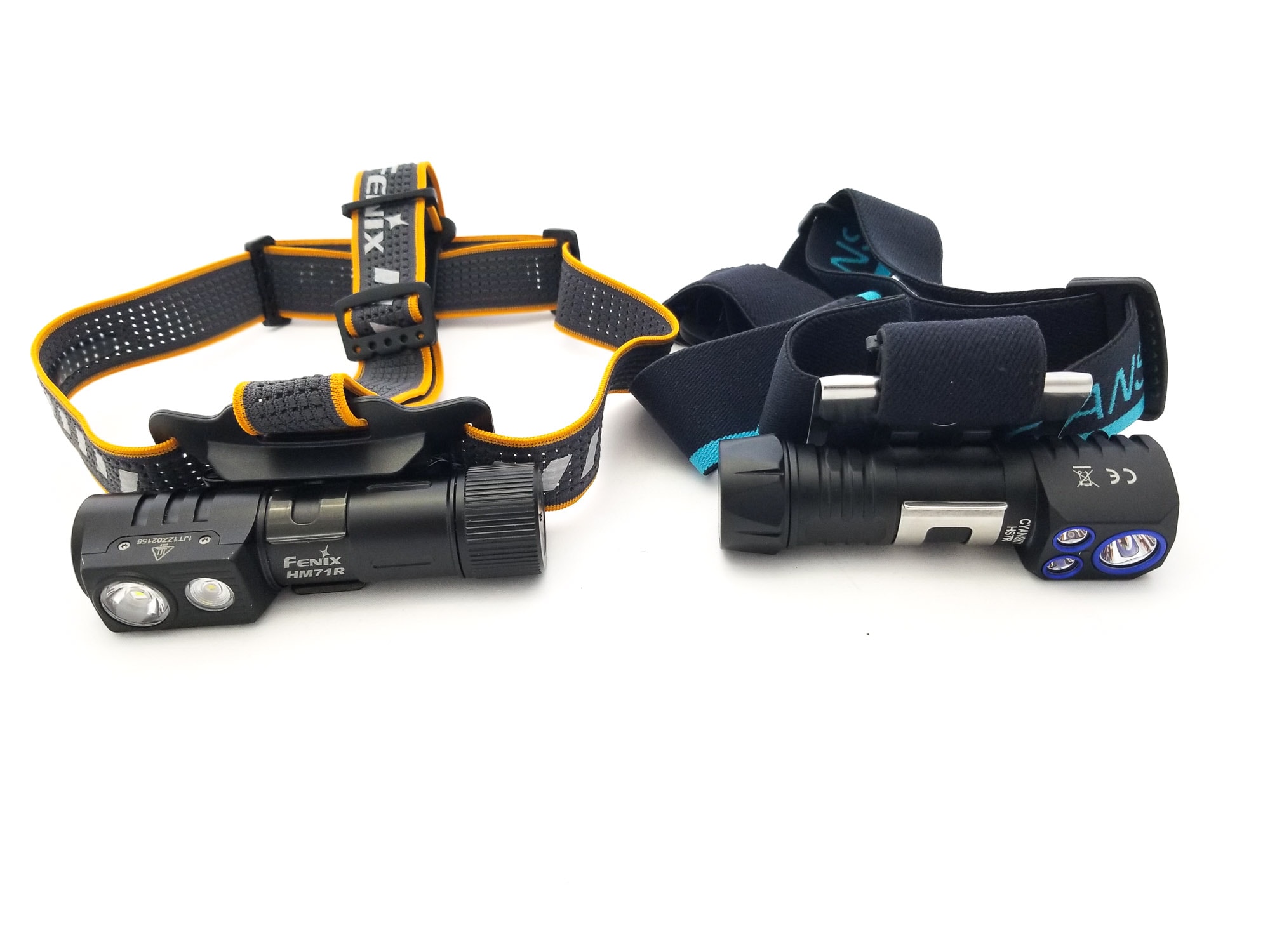
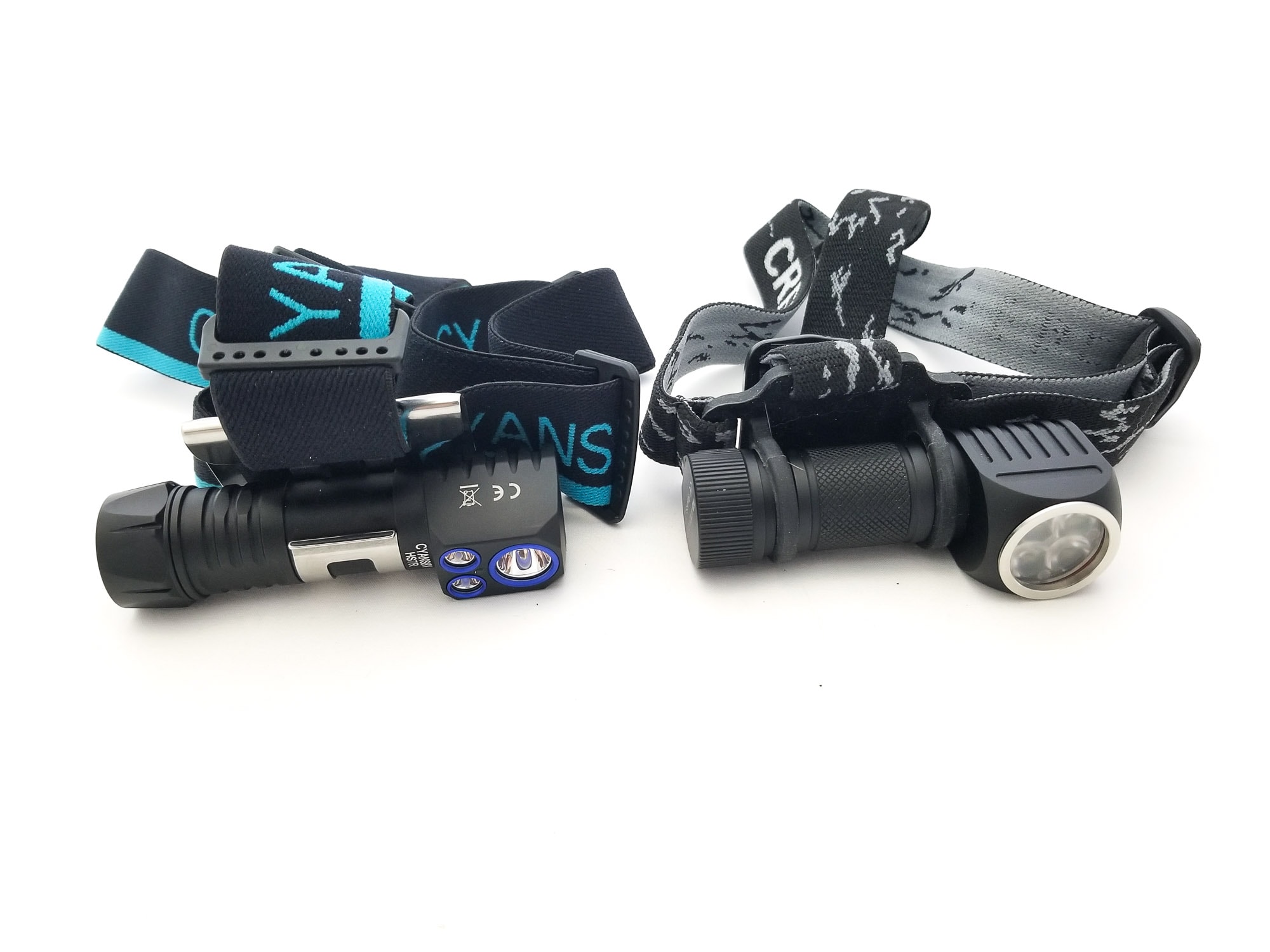
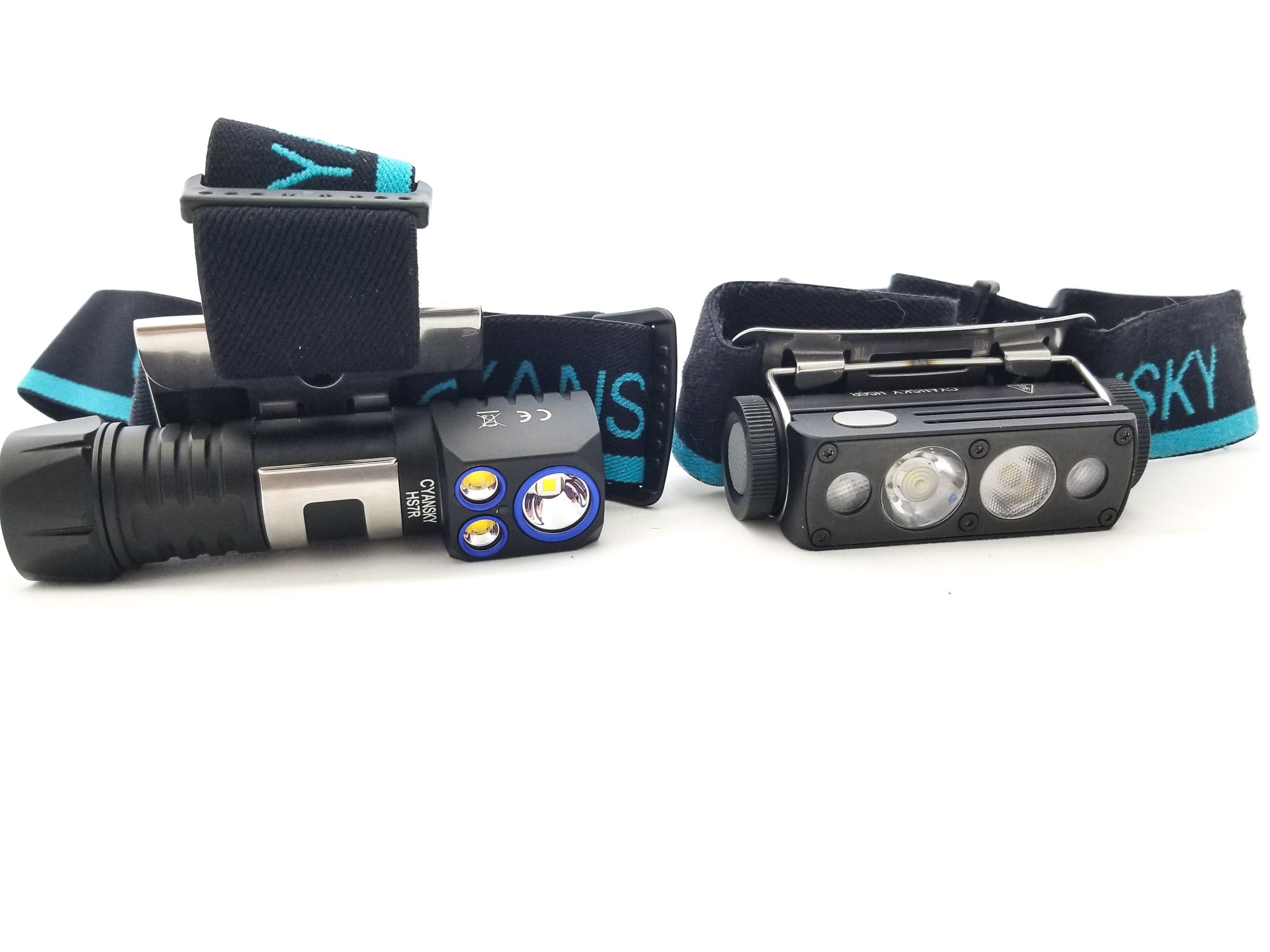
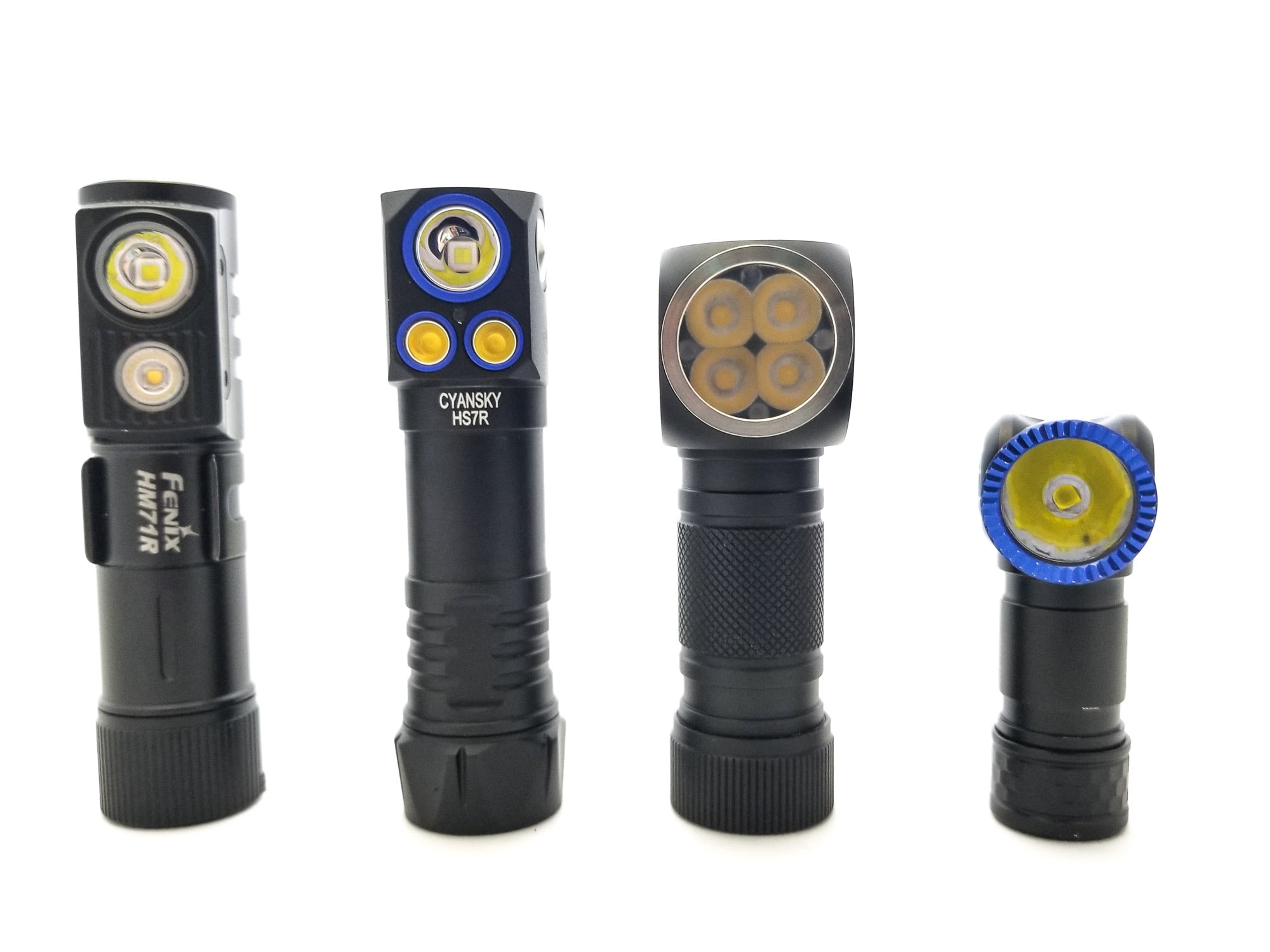
Cyansky HS7R UI: User Interface and Driver
Cyansky’s lights usually have buck or boost drivers, and the HS7R is probably sporting a dual-channel boost/buck driver since it has to power a 6 volt and 3 volt LEDs. This is great for laminar output that doesn’t track with the battery voltage sag, so you get constant output so long as the battery can supply enough power to keep the boost IC happy.
The UI is pretty standard for a dual LED, dual switch headlamp, but Cyansky packages this one nicely on the HS7R. Both LEDs share the same modes, and I like this idea since some others might clip off a mode (or two), or switch them around (swapping Moon for Low, or Turbo for High). On the HS7R, you get two Lows, two Mediums, and two Turbos! Oh, and blinkies? This UI is blinky-less.
Available modes (flood LED and spot LED):
- Low, Medium, High Turbo
Available blinky modes:
- None
Switching between Spot and Flood LEDs:
- In spot/flood function, press and hold the flood/spot LED switch for 0.5 seconds to switch between flood and spot LEDs.
From OFF (for both spot and flood LEDs):
- Press and hold for 0.5 seconds: Turns on in last used mode
- Single click: Battery check-top switch LED will show battery state
From ON (flood and spot LEDs):
- Press and hold for 0.5 seconds: Turns off
- Single click: Switches through the modes
- Double click: N/A
Mode memory:
- Remembers the last used mode. In my testing, the light didn’t remember Turbo for either the flood or spot function
Shortcuts:
- N/A
Proximity Sensor Control:
- The light proximity sensor is enabled by default, but can be disabled pretty easily for both the flood and spot LED functions. To disable the proximity sensor, in either the spot or flood mode activated, press the flood or spot LED switch 2 times. The spot LED will blink 3 times to indicate the sensor has been disabled. NOTE: The sensor is only disabled when the light is turned on. As soon as it’s turned off, it reverts back to the default state and the sensor must be deactivated again!
Low voltage warning:
- The top switch LED shows battery state from OFF with one click, and during operation:
- Solid green 75-100%,
- flashing green 50-75%,
- solid red 25-50%,
- flashing red <25%.
- When the battery gets to 3 volts, the output drops to a very low level before the light shuts down at around 2.7 volts.
Strobe/blinkies
- None
Lock-out mode:
- From off, with either the spot LED switch or flood LED switch, press and hold for 3 seconds and the flood or spot LED (whichever button you use) will flash 2 times to acknowledge the lock. If the buttons are pressed, the light flashes (spot or flood) 2 times on Low mode. To unlock, press and hold again for 3 seconds and the light unlocks and switches to Low mode on either the flood or spot LED. Note that connecting the charging cable while locked also unlocks the light.
PWM
- None visible
Additional/summary info on the UI:
- I really like this UI. It’s easy to negotiate and learn, and it’s simple! I like how Cyansky gave each lighting mode an equal number of modes (including Turbo), and while I think it might be a little busy, the fact that they omitted blinkies doesn’t bother me either.
- I wished they made it so you could have both the flood and spot LEDs active simultaneously like on the HS6R, but I’m not complaining one bit about that since the UI and all the functionality is very good as-is, and it’s worth mentioning that while I’m not crazy about press and hold for on/off, I don’t mind it too much here. I do miss a low-low mode, since the Low mode, isn’t.
Cyansky HS7R Charging and batteries
The HS7R features the flagship headlamp battery these days, the 21700 size lithium ion cell. These are the go-to battery for high output lights, and it makes sense that Cyansky uses one here (and to stay competitive).
Cyansky included their very nice BL2150U 5000 mAh 21700 cell with the HS7R. This cell features integrated USB type C charging and a protection circuit and a button top. It’s pretty long too, a full 77 mm long, but it did fit in my VapCell S4+ just fine. The internal resistance came out to about 15 milliohms, so it will have about the same performance as a Panasonic Tesla cell. Due to the lack of a spring on the driver and the presence of interference bars for reverse polarity protection, you’re limited to button tops.
My button top unprotected Samsung 50G cells fit fine, but flat tops were a no-go, and that doesn’t bother me since this light doesn’t need a hot rod battery, and the included cell is perfectly adequate.
The battery was sitting at 3.59 volts out of the box, and a full charge netted 43632 mAh and 4.13 volts per the Ruideng AT35 USB tester. On USB type A to C, I saw about 1.7 amps and 5 volts. Switching to USB type C to C didn’t change that. Using the built-in charging, the current drops a bit. Expect a discharged cell (from 2.89 volts) to top off in about 3.5 hours. The termination voltage is a bit low, but that helps the cell live a long time.
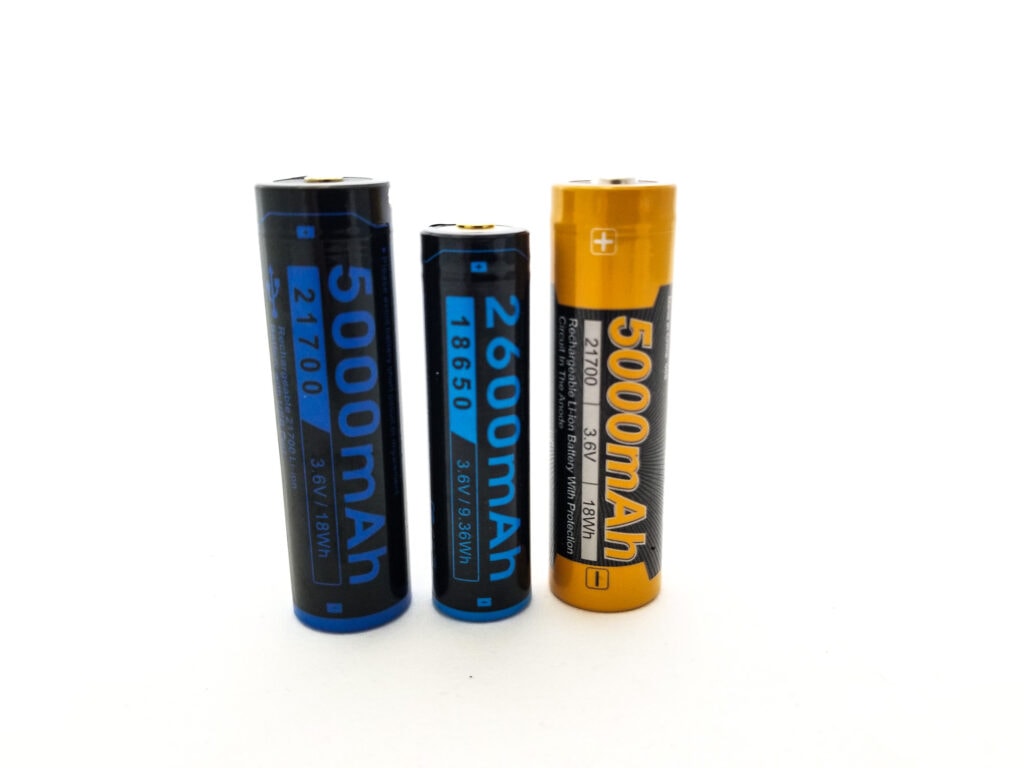
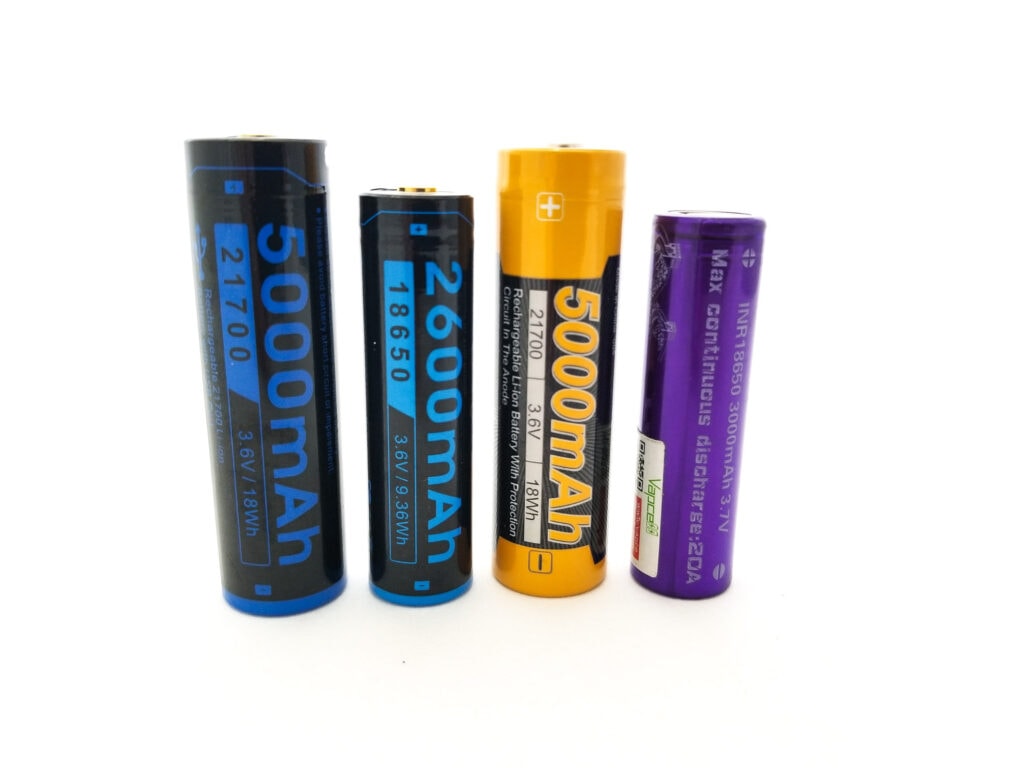
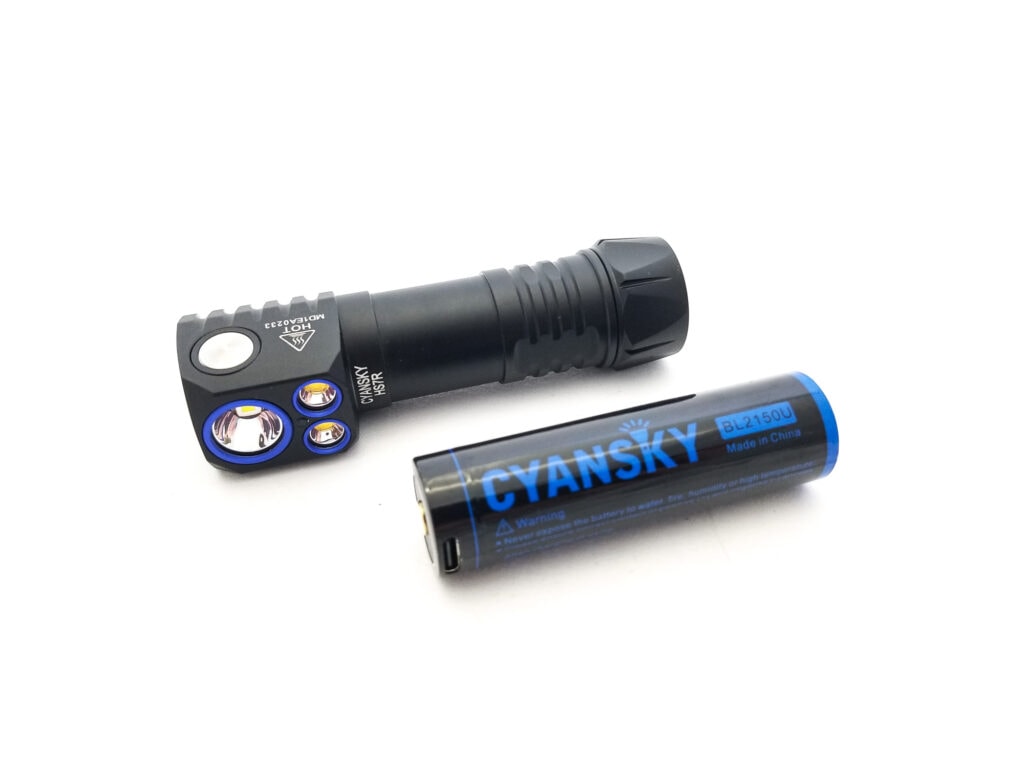

Performance test
Lumen measurements
How Lumens are Measured: Understanding ANSI FL1 Standards How Lumens are Measured: Understanding ANSI FL1 Standards: The ANSI FL1 standards specify that output in lumens should be measured 30 seconds after turning on, as this is the standardized time for measuring brightness according to the industry standard. This is why we focus on this part in our measurements. The ANSI FL1 standards require an ambient temperature of 22 ± 3°C. We record the ambient the ambient temperature to identify potential reasons for any observed discrepancies.Lumens are measured in my 30 cm integrating sphere with a Digi-Sense 20250-00 data logging luxmeter. The sphere has been calibrated with a Convoy S2+ measured to 260 Lumens and the figures are within 10% of actual. I used my Thisinde B18B+ digital multimeter with 14 gauge wires on banana plugs directly in the meter. For current over 7 amps, I used my FY219 clamp meter with a short loop of 10 gauge wire. I used the included Cyansky 5000 mAh 21700 for the test.
Lumen measurements (for each mode)
| Mode | Amps at start | Specs | turn on | 30 sec | 10 minutes |
|---|---|---|---|---|---|
| Spot LED | |||||
| Low | 73 mA | 50 | 42.4 lm | 42.4 lm | – |
| Medium | 326 mA | 200 | 173 lm | 173 lm | – |
| High | 1.64 A | 800 | 697 lm | 689 lm | 556 lm |
| Turbo | 11.3 A | 2800 | 2324 lm | 1851 lm | 663 lm |
| Flood LED | |||||
| Low | 32.5 mA | 15 | 11.2 lm | 11.2 lm | – |
| Medium | 179 mA | 100 | 83 lm | 83 lm | – |
| High | 1.04 A | 500 | 564 lm | 564 lm | 556 lm |
| Turbo | 6.9 A | 2000 | 1660 lm | 1560 lm | 664 lm |
Parasitic drain:
- 0.06 mA (nice and low!)
Cyansky HS7R Battery Life: Runtime graphs
How Runtimes are Measured: Understanding ANSI FL1 Standards About ANSI FL1 runtime standards: The runtime is measured until the light drops to 10% of its initial output (30 seconds after turning on). This does not mean that the flashlight is not usable anymore. The last column shows how long the light actually works till it shuts off. If there is a + symbol, it means that the test was stopped at that particular point, but the light was actually still running. This happens on certain occasions, with certain drivers, firmware, or batteries.Runtimes are measured in my 30 cm integrating sphere with a Digi-Sense 20250-00 data logging luxmeter. The sphere has been calibrated with a Convoy S2+ measured to 260 Lumens and the figures are within 10% of actual. I measure temperature readings with my Digi-Sense 20250-92 data logging thermocouple. The thermocouple is affixed to the head with kapton tape, and I used the same 5 second sampling rate as the luxmeter. I used the included Cyansky 5000 mAh 21700 for the test. I tested High and Turbo modes for each of the lighting modes since the Medium modes run a very long time.
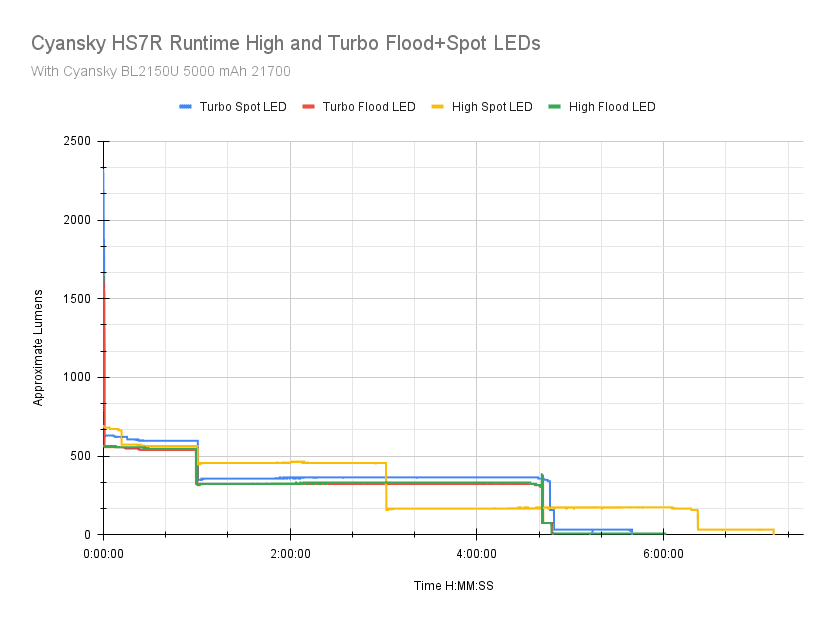
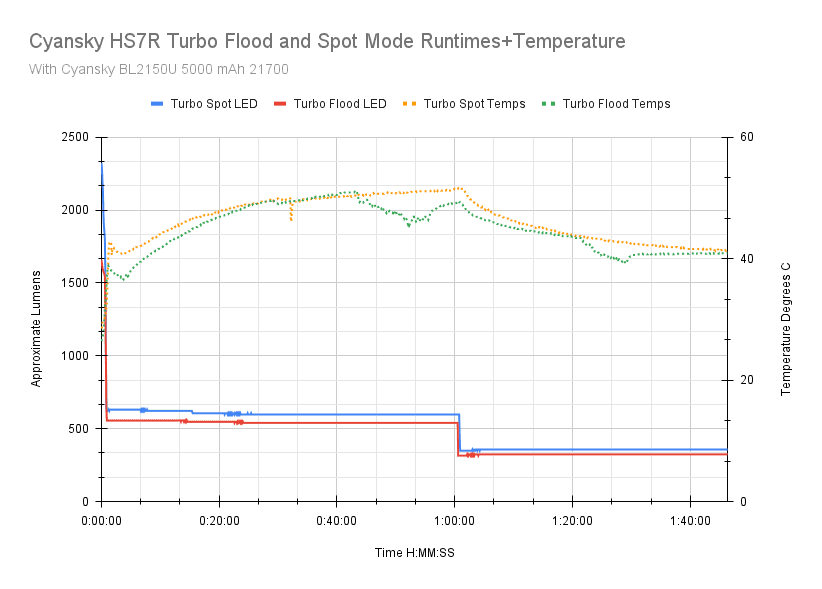


| Mode | Specified | Measured runtime ANSI | Time till shut off |
|---|---|---|---|
| Spot LED | |||
| High | 6h | 6h 22m | 7h 10m+ |
| Turbo | 4h | 4h 47m | 5h 39m+ |
| Flood LED | |||
| High | 9h 30m | 4h 47m | 6h 1m+ |
| Turbo | 4h 30m | 4h 42m | 4h 49m |
The driver is nicely regulated after the step downs from the Turbo mode(s), and sustained brightness isn’t bad at all for a small’ish headlamp. The runtimes look good except for High on the flood LED, and I’m not sure about this one since the ANSI was finished after about 55% of the advertised runtime, and the light kept running at a low level until I ended the rest at a little over 6 hours in. This was repeated with the Spot LED’s high mode, where it ran way past the expected shut down after stepping down to a very low level around the 6h 22m mark. It as the same with the Turbo setting in Spot LED, with plenty of usable light left after the last step down at around the 4h 47m mark. Overall, this a nicely regulated driver and makes good use of the Osram and Luminus LEDs. For temps, the light lingered on without getting burning hot, settling around 50 C for the Turbo tests, and under 50 C for the High test. It did heat up quick though, which is expected for high output in a small host. I did notice some visual LVP blinks towards the end of the runtimes, but I only observed it on the High mode runtime after the last step down.
Peak beam intensity and beam distance measurements
About Peak beam intensity: Understanding ANSI FL1 Standards About peak beam intensity The calculated value of distance in meters at which the flashlight produces a light intensity of 0.25 lux. (0.25 lux is about the brightness of a full moon shining on an object). This means that the intensity has decreased so much, it becomes difficult to see darker objects, or objects that don’t reflect light. The columns ‘Meters’ and ‘Yards’ use rounded numbers.The beam distance test was conducted using the Uni-t UT383S luxmeter at a distance of 5 meters. I used the included Cansky 5000 mAh 21700 for the test. Measurements taken at 30 seconds per ANSI spec.
| Mode | Specs | Candela measured | Meters | Yards |
|---|---|---|---|---|
| Spot LED | ||||
| Low | 156 | 200 cd | 28 m | 30 yd |
| Medium | 650 | 825 cd | 57 m | 62 yd |
| High | 2500 | 3475 cd | 118 m | 129 yd |
| Turbo | 8649 cd | 4900 cd | 140 m | 153 yd |
| Turbo at start* | 10,650 cd | 206 m | 225 yd | |
| Flood LED | ||||
| Low | 25 | N/A | – | – |
| Medium | 100 | 100 cd | 20 m | 22 yd |
| High | 1024 | 825 cd | 57 m | 62 yd |
| Turbo | 2070 cd | 2250 cd | 95 m | 104 yd |
The beam distance figures look good also. I didn’t get a reading for the flood Low mode (too dim at 5 meters). The flood LED is nicely floody, and the spot LED gives good beam distance. The ANSI candela figure for the Turbo mode spot LED is a bit low because the output is dropping rapidly by 30 seconds, but the start figure is on point.
Beamshots
Camera settings and distance: Photos taken with my Samsung Note 8 set to 0.3s ISO 200 and 5000K WB. The fence is 40 meters distant. You can see the difference in the different LEDs and reflector configurations.
Beamshots of the following headlamps compared:
- Cyansky HS7R
- Fenix HM71R (spot and flood modes)
- Fenix HM70R (T-type headlamp spot and flood modes)
- BioLite 800 Pro (spot and flood modes)
- Brinyte HL18
- Cyansky HS3R
- Cyansky HS6R (flood and spot modes)



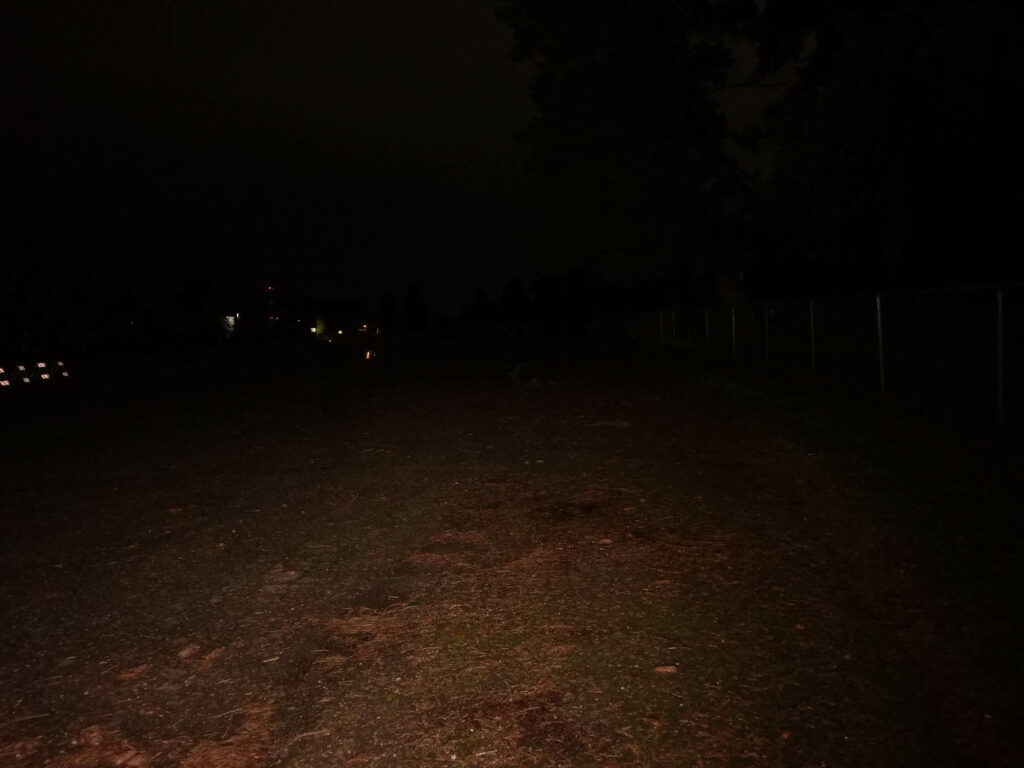
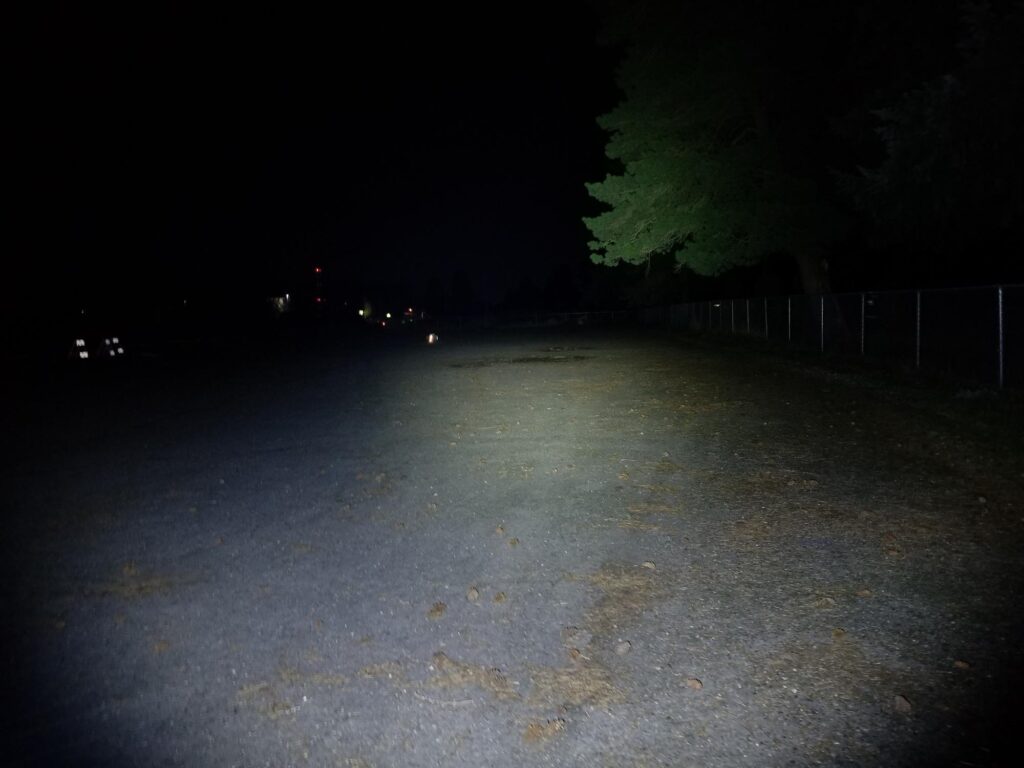
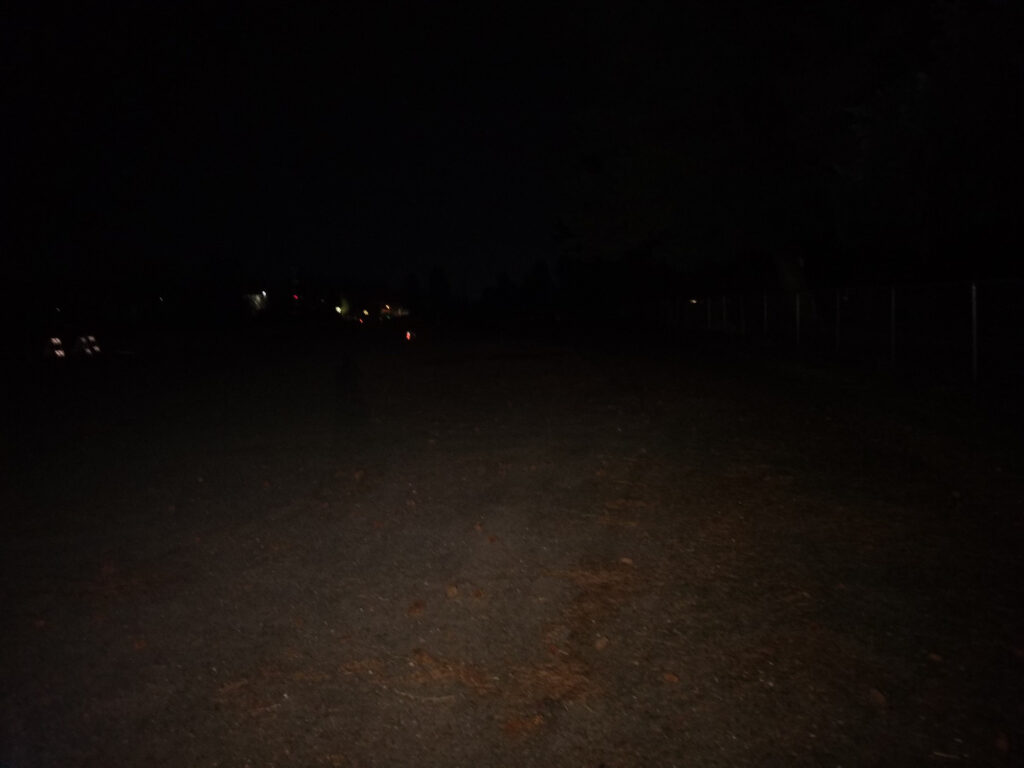
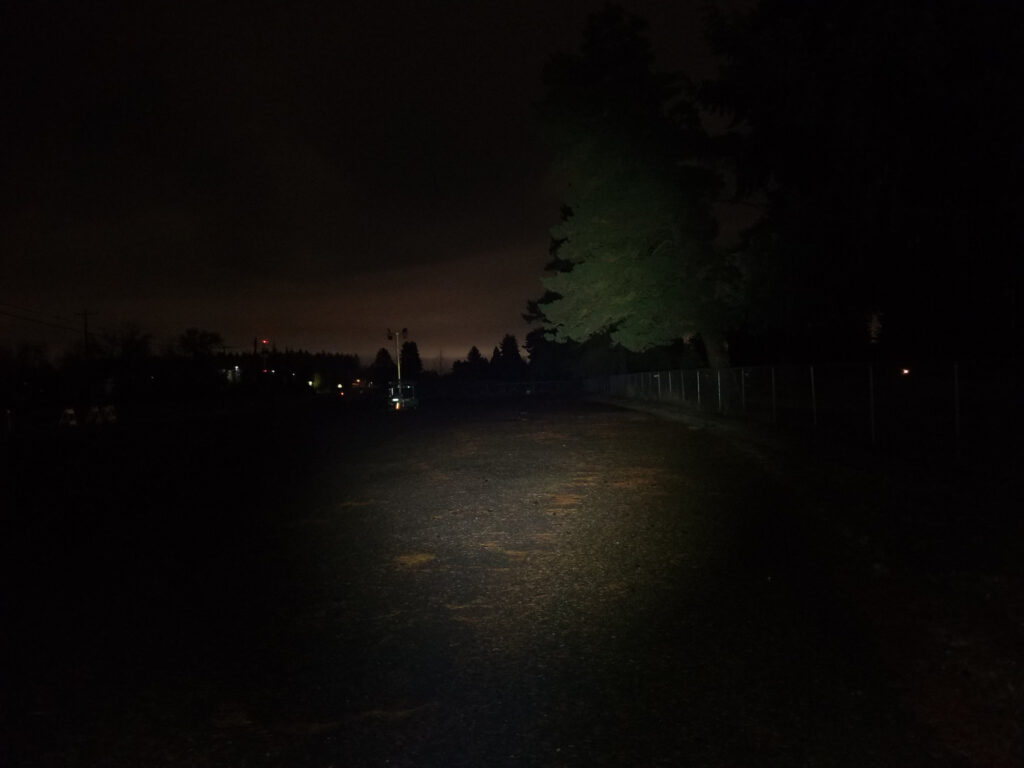
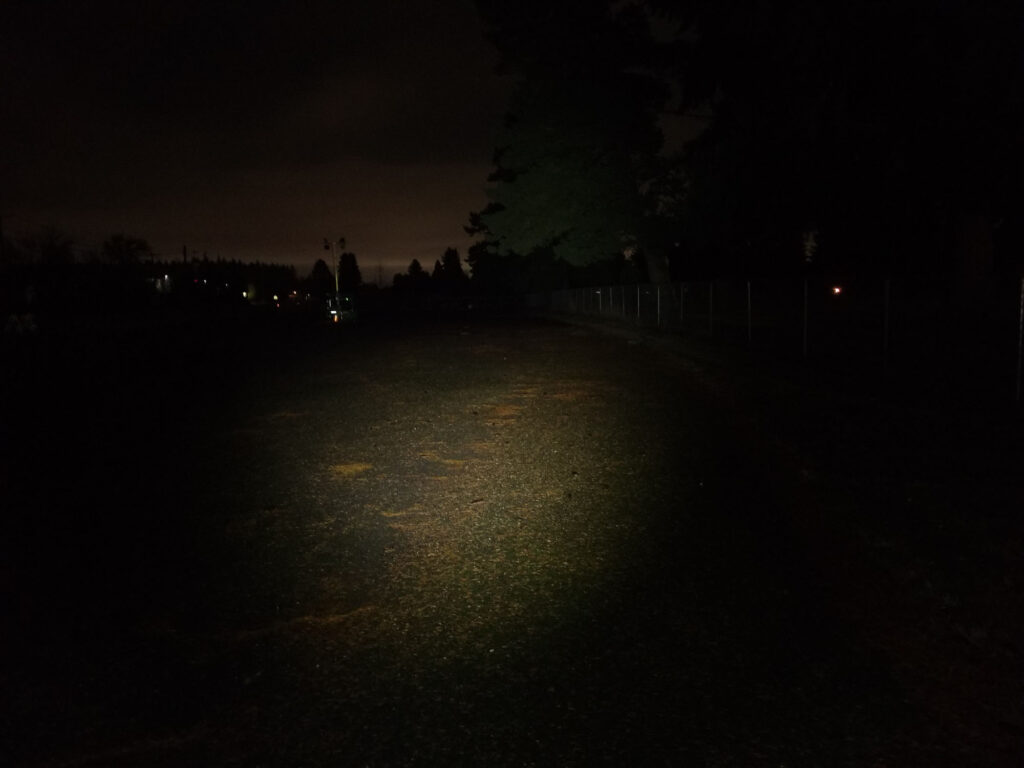
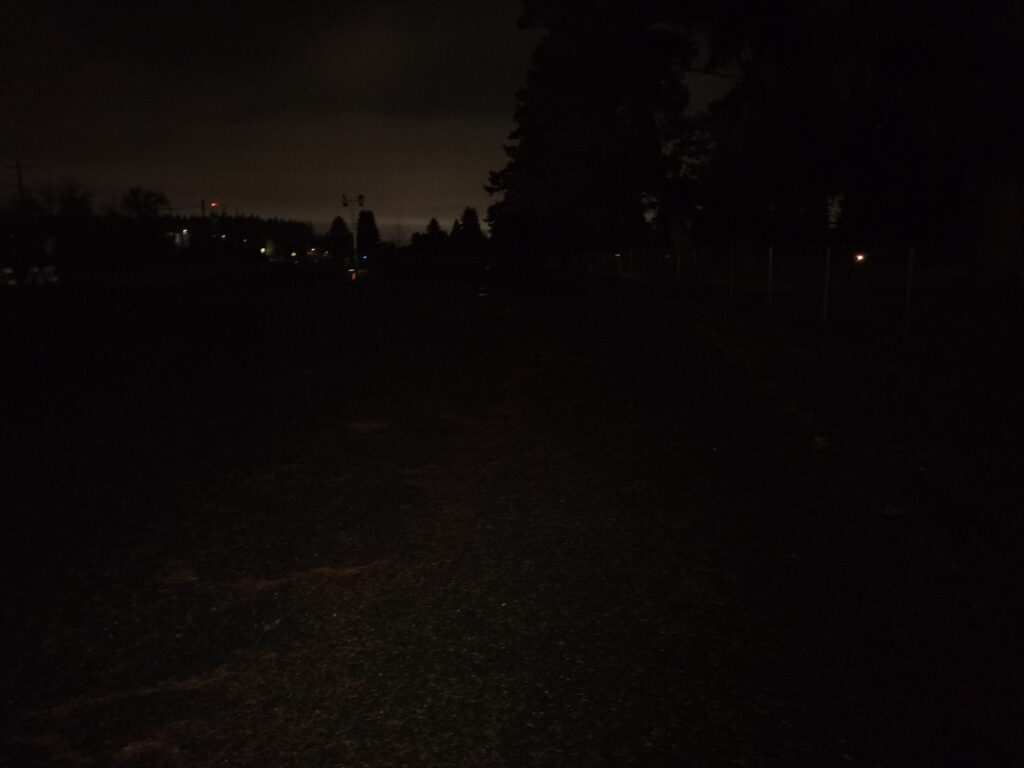
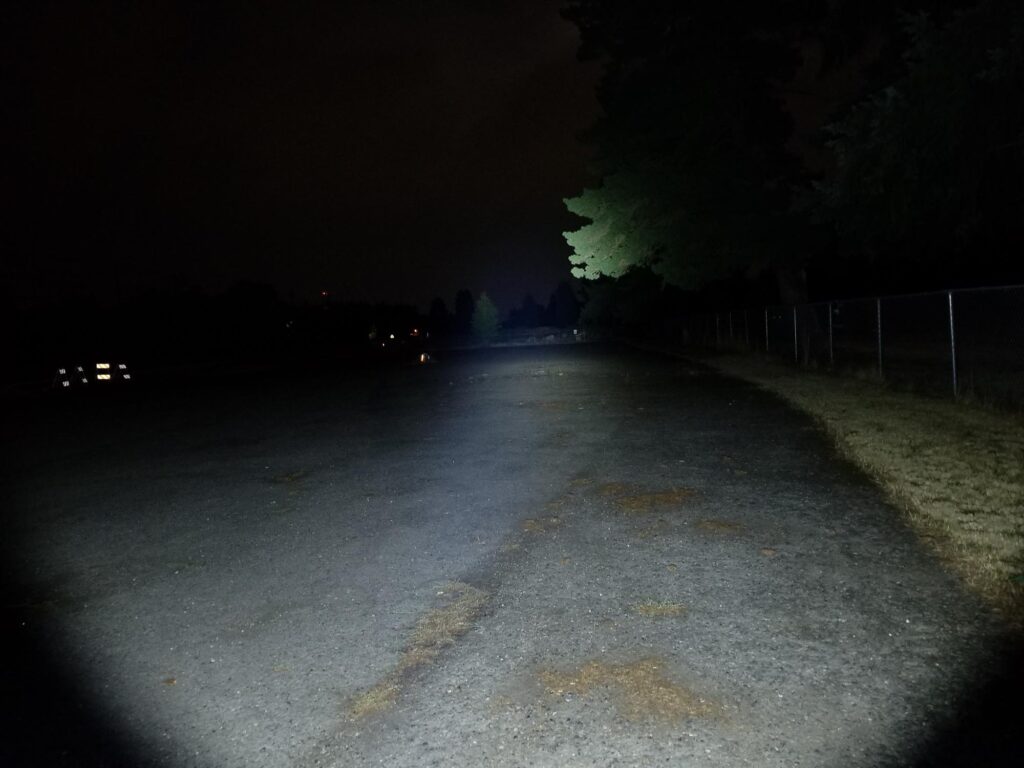
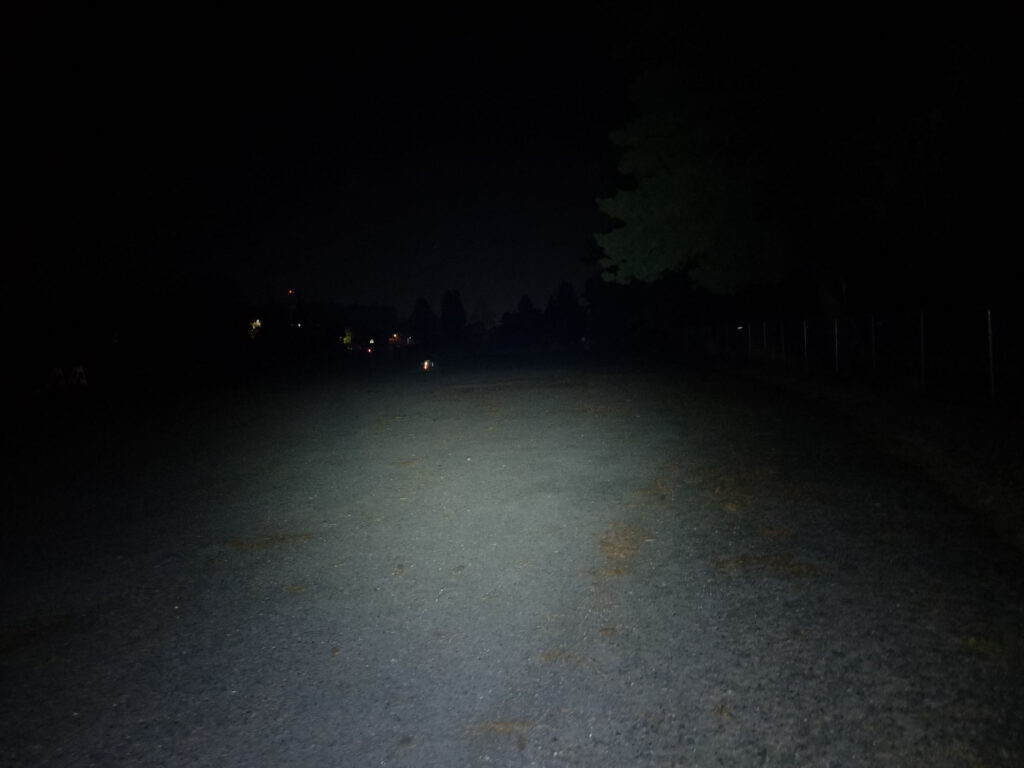
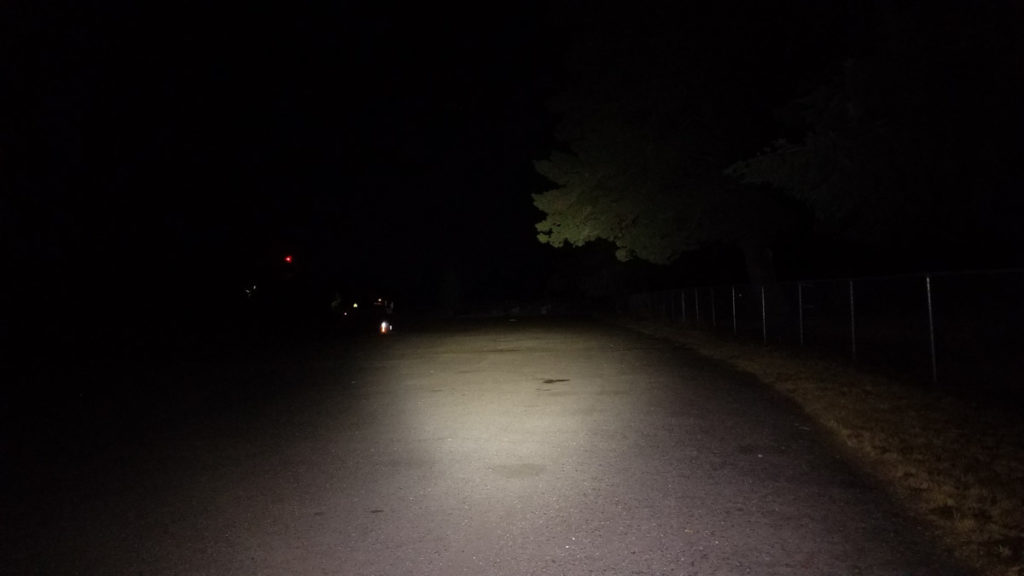
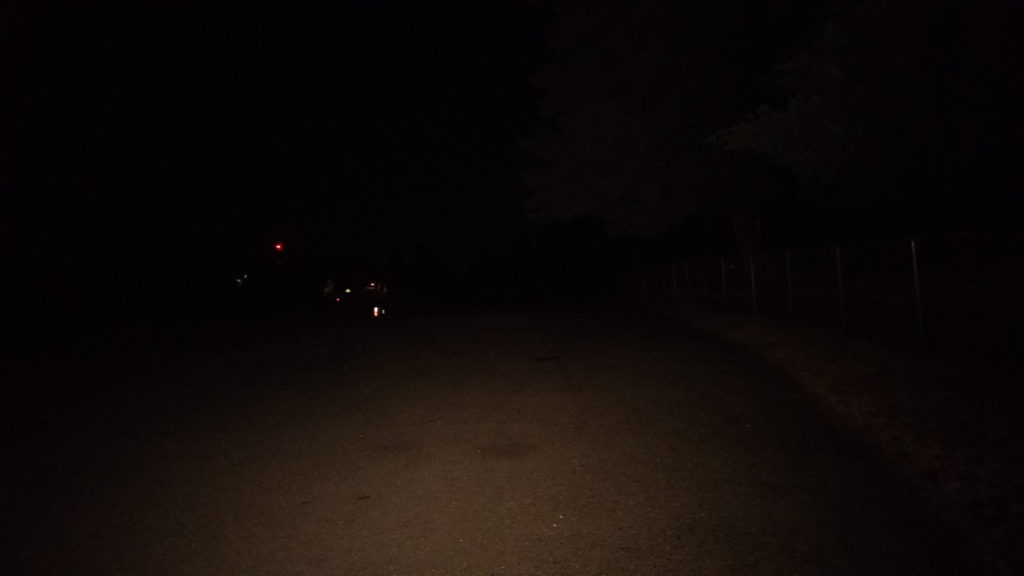
Disclaimer: This flashlight was sent to me for review at no cost by Cyansky. I have not been paid to review, nor have I been holding back on problems or defects.
Final Verdict
Pros
- Great build quality
- Onboard USB type C charging
- High output for both lighting modes
- Regulated buck/boost driver
- Simple UI
- Can disable the light proximity sensor
- Very comfortable headband and improved mount
Cons
- Quick step downs on Turbo for both lighting modes
- Not reaching claimed output
- Light proximity sensor is only disabled while the light is turned on-resets after turning off
- Low CRI for the warm white LEDs
Explanation on star ratings:
1: Avoid: a match would be a better choice – 2: Poor: significant defect or issues; almost unusable – 3: Average: some defects or issues; but still usable 4: Good: recommended (minor issues) – 5: Great: highly recommended

4.5 stars: ★★★★⋆
While our star rating provides a reliable indicator, we encourage you to read the full review to make an informed decision based on your own needs and preferences.
Cyansky pretty much hit it out of the park with the first dual-LED HS6R headlamp, and it’s one of my most-used headlamps to date, so this new one had some big shoes to fill. Well, I can say that although this one’s not my preferred form factor, this HS7R ended up being one of the better dual-purpose headlamps I’ve tested to date, and that’s saying a lot. The competition is pretty stiff as well, and this release is hot on the heels of the newly redesigned Fenix HM71R headlamp (which I also reviewed). Well, I can honestly say that this new HS7R is a good one. Cyansky got a lot of things right here, and it’s nice to see them incorporate the latest high output LED from Luminus, and while not high CRI, warm white LEDs for their flood lighting mode. The 21700 is a must here, and how they kept it so lightweight is beyond me. It checks off all the right boxes as well with things I expect from a higher-end headlamp like USB type C charging and a fully regulated driver. The headband is just as comfortable as I remember it from the HS6R, and I really appreciate the updated mounting system. It makes the headlamp much easier to extract and reinstall from the mount (without scratching up the headlamp, mind you).
Despite being small, it manages some decent output, and while I didn’t expect good sustained output, honestly it’s not bad. While I’m not a huge fan of proximity sensors on flashlights, I do like that Cyansky made it so you can disable it (well, temporarily). The UI is simple and straightforward as well. The stepdowns on Turbo are pretty quick, but that’s expected here so I can’t fault it too much.
I didn’t like the way they implemented the proximity sensor deactivation though. It should at least remain deactivated as long as you’re in that same lighting mode. Lastly, while I’m glad to see some warm-tinted LEDs for the flood mode, they’re low CRI when everyone else is fielding 95+ CRI warm white LEDs, and yes, it makes a difference. Final thoughts? If you’re looking for a high output, lightweight headlamp that has great beams, long runtimes, and fully regulated output with one of the most comfortable headbands around, give the HS7R a look. It will definitely be in my headlamp rotation for quite a while. 4.5 stars for the HS7R.
Buy your Cyansky HS7R here
1lumen selects and reviews products personally. We may earn affiliate commissions through our links, which help support our testing.